
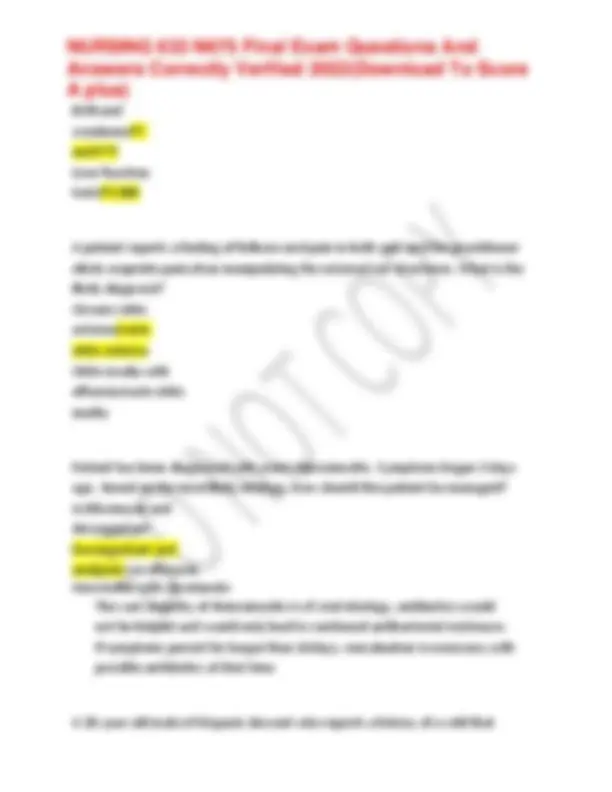
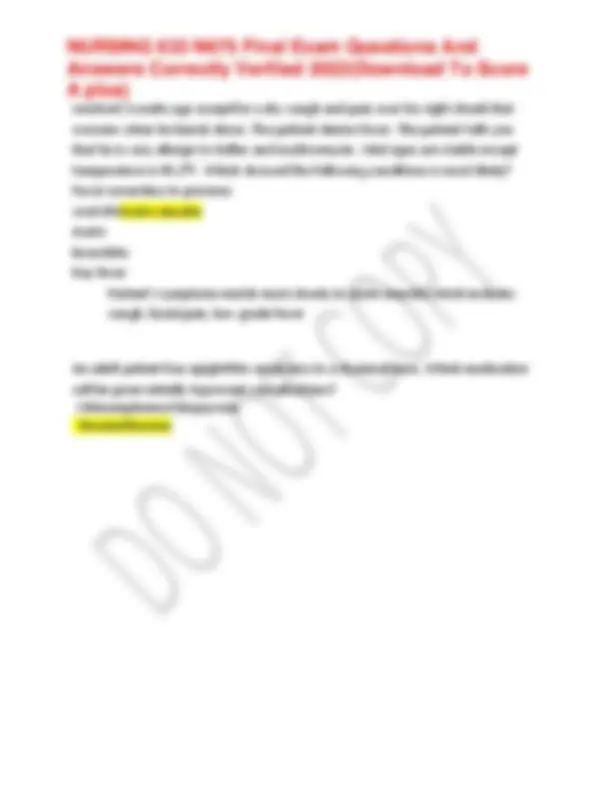
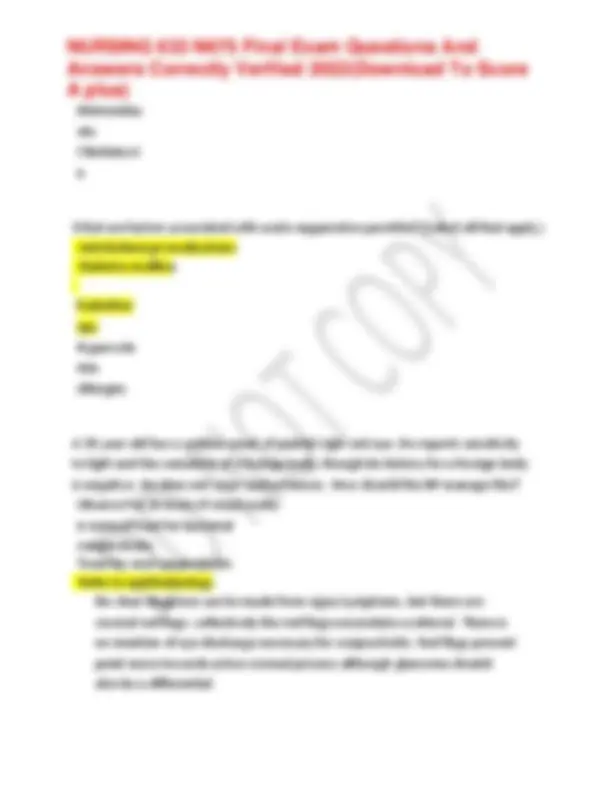
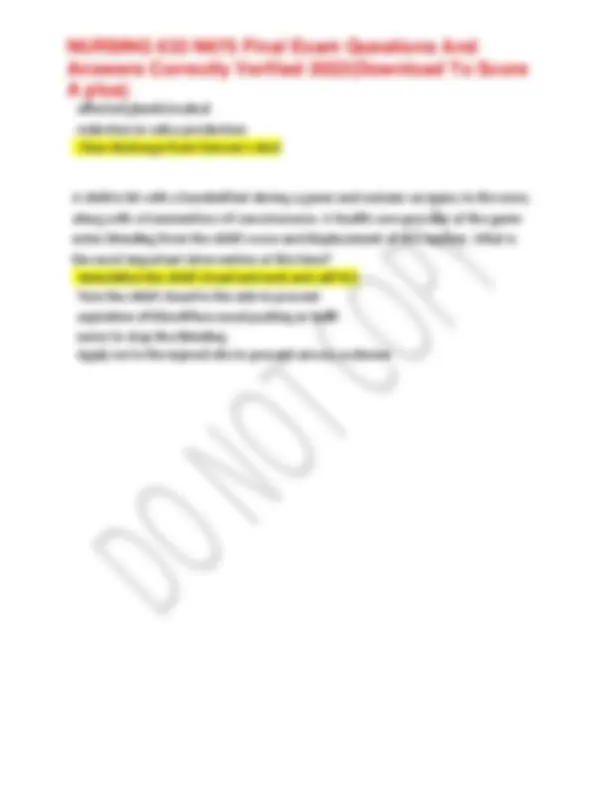
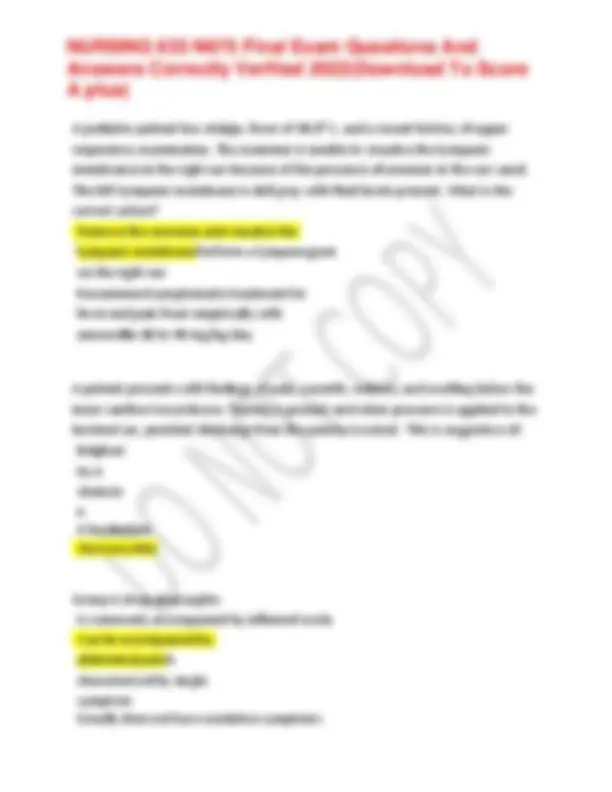
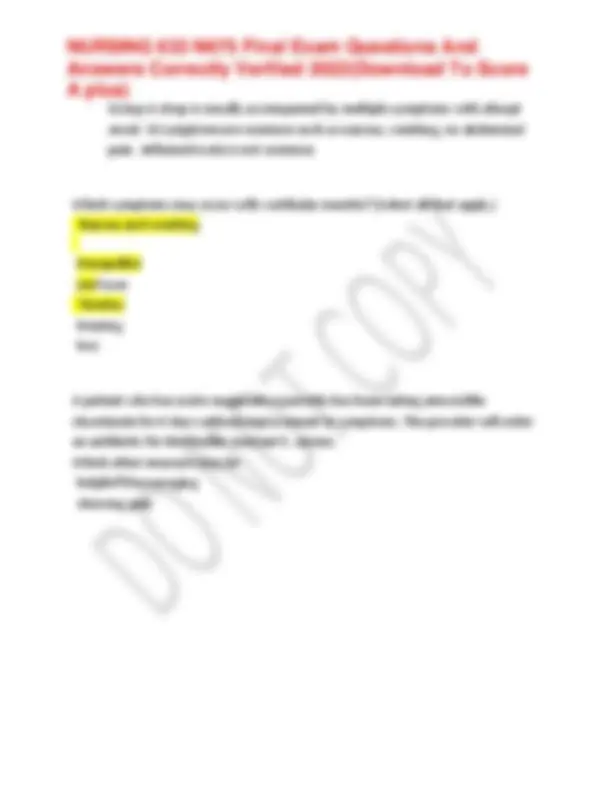
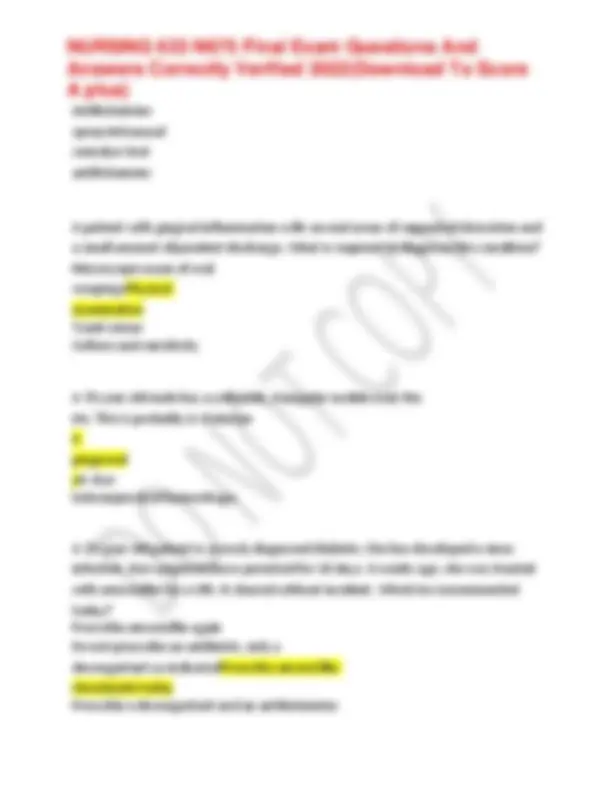
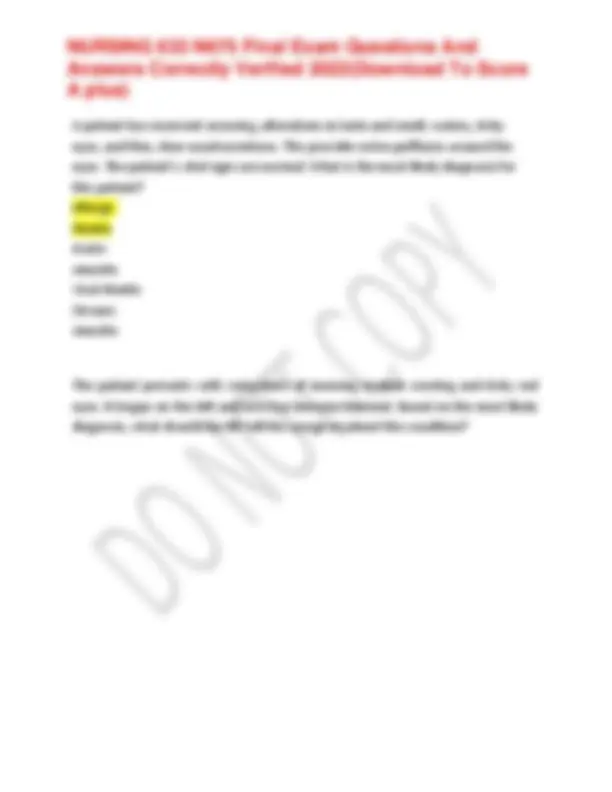
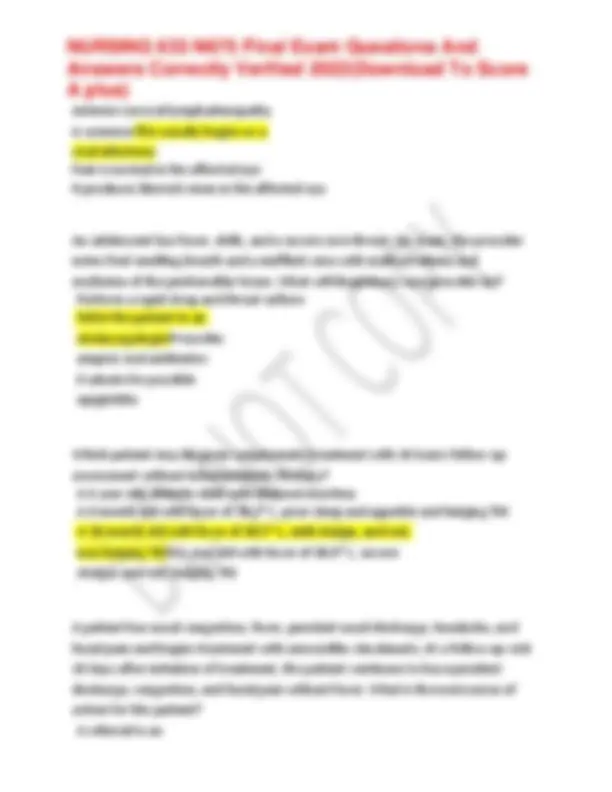
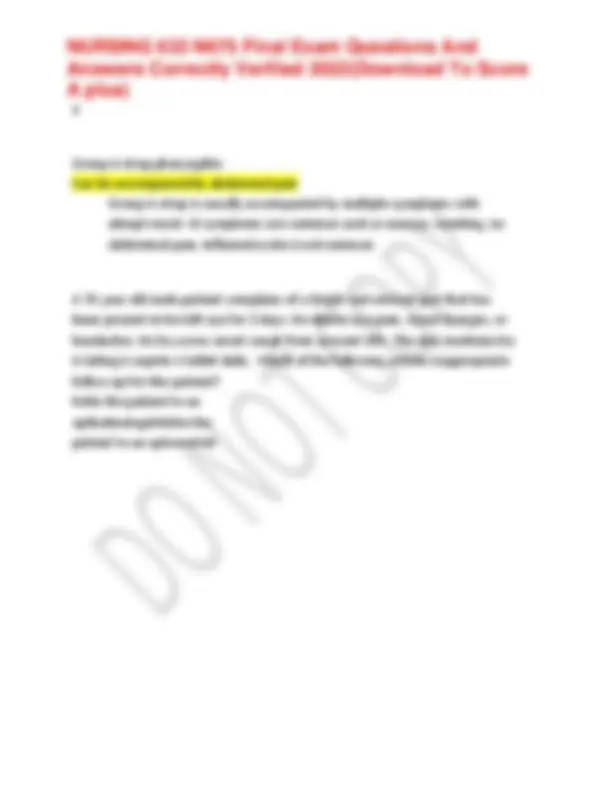
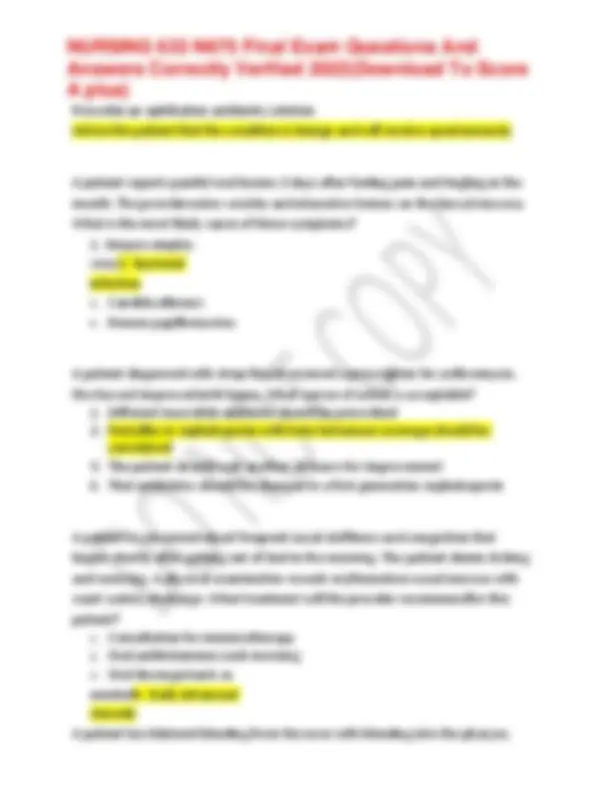


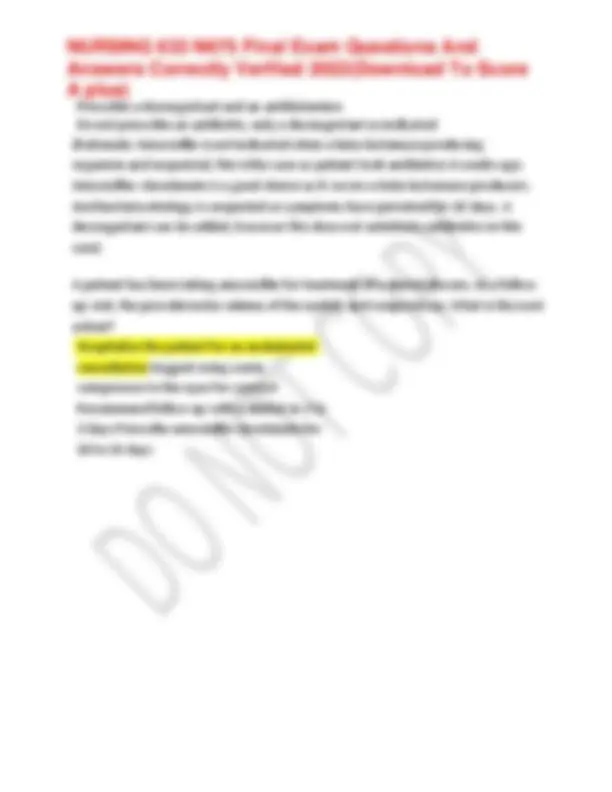
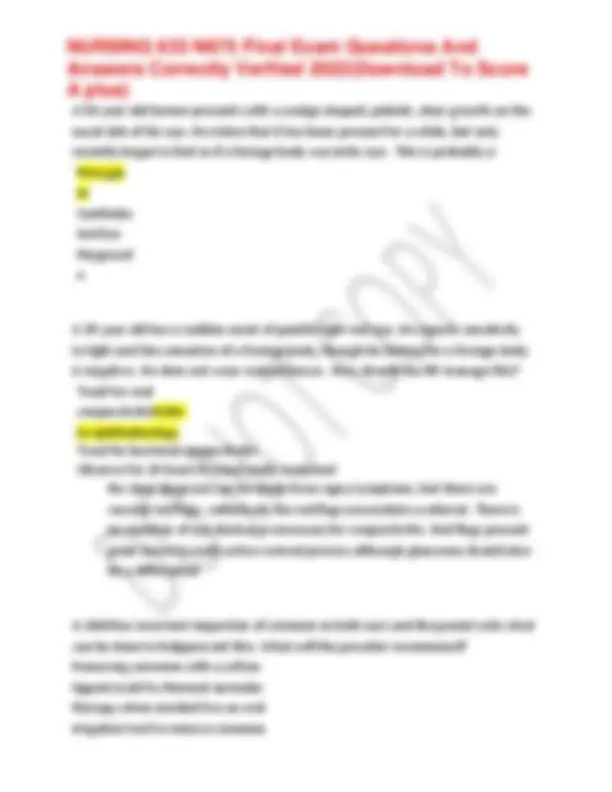
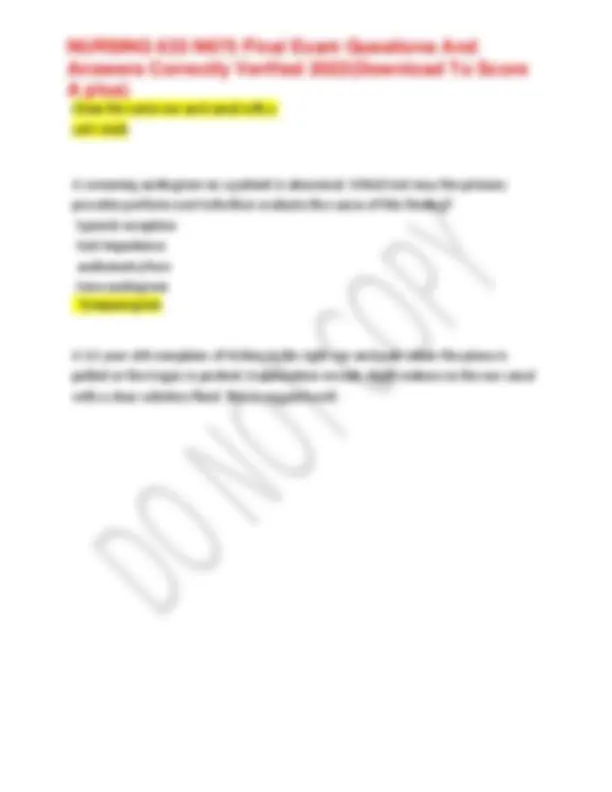
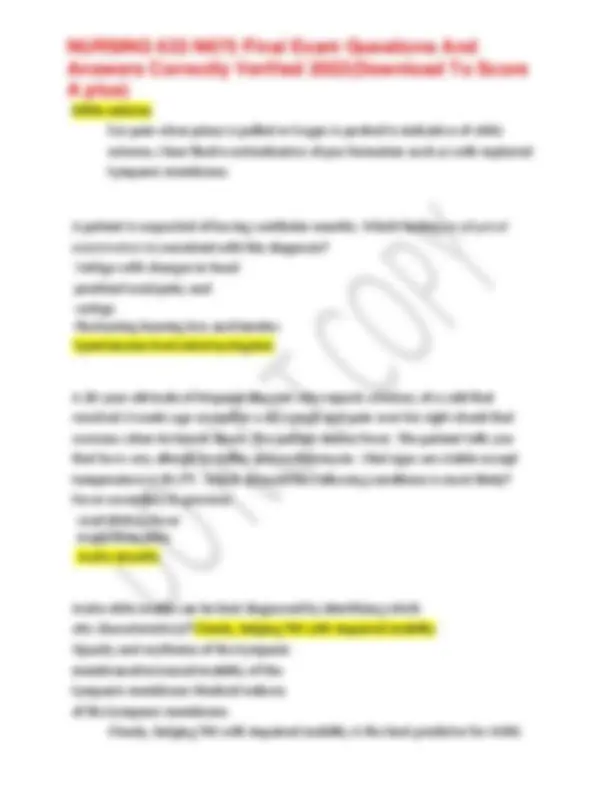

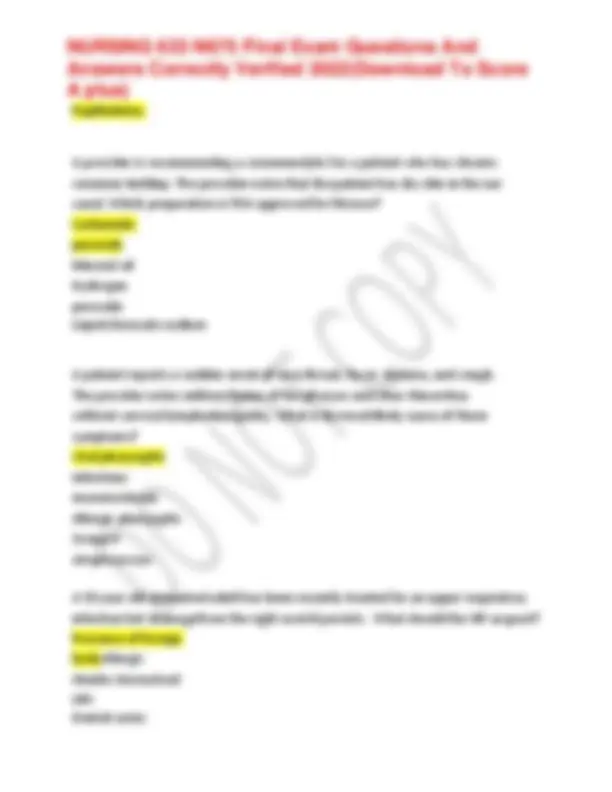
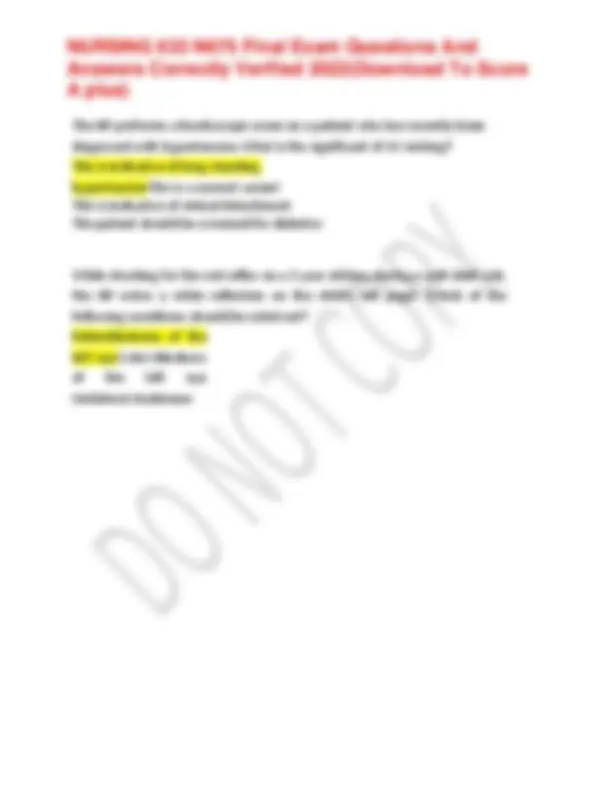
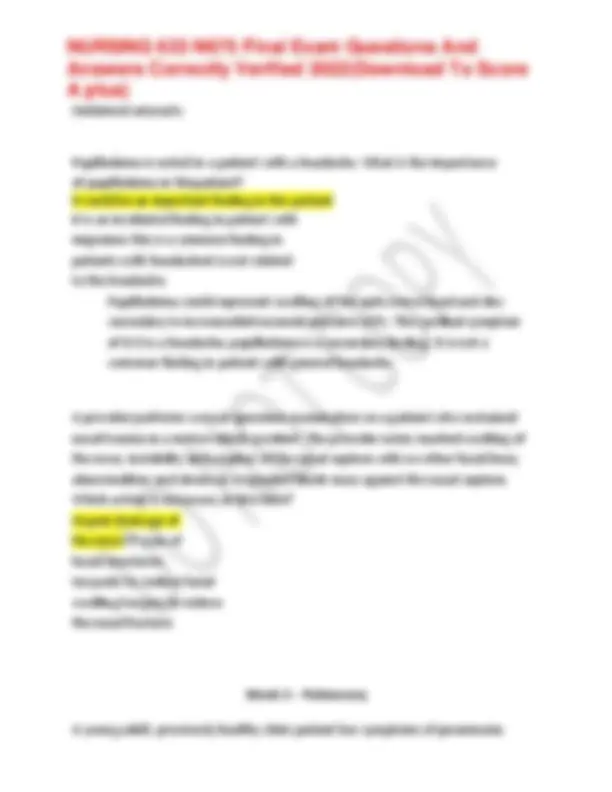
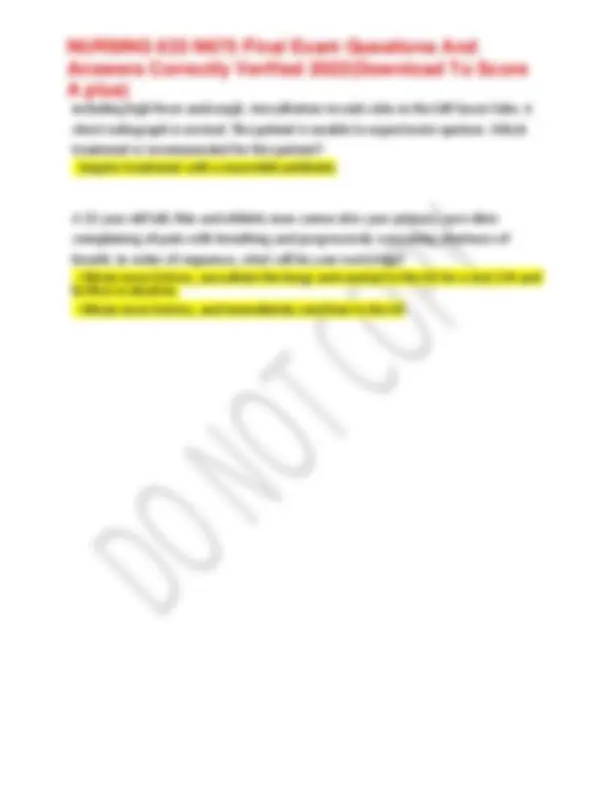
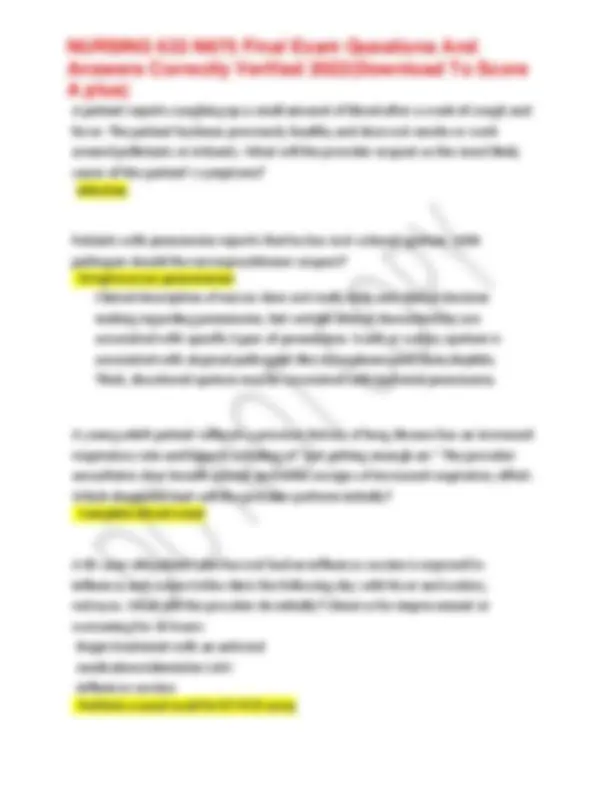
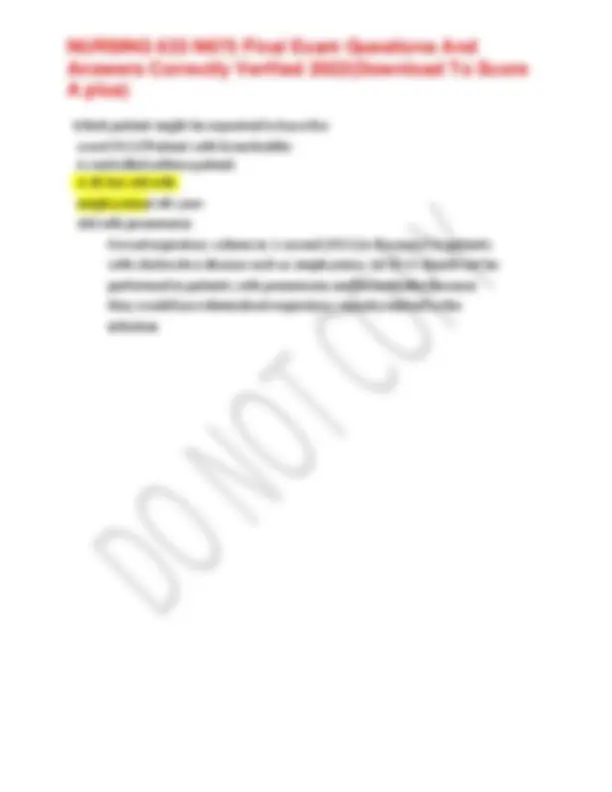
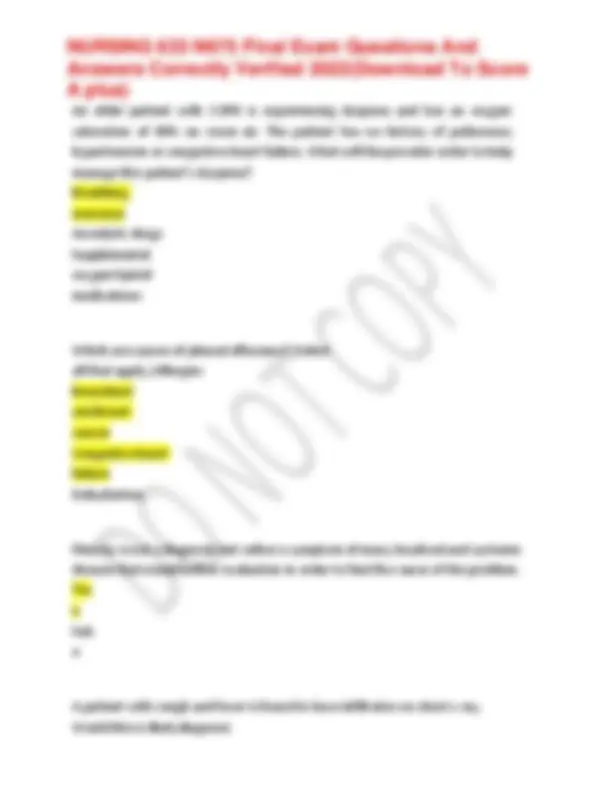
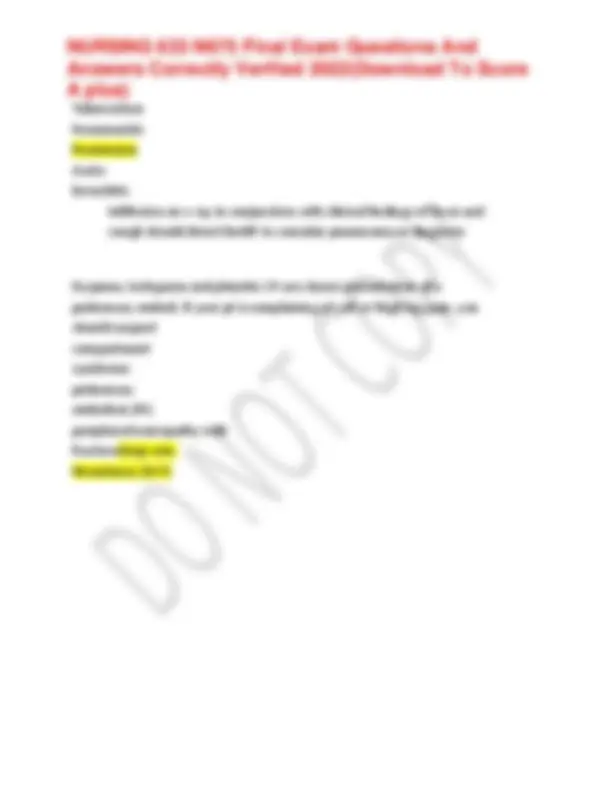
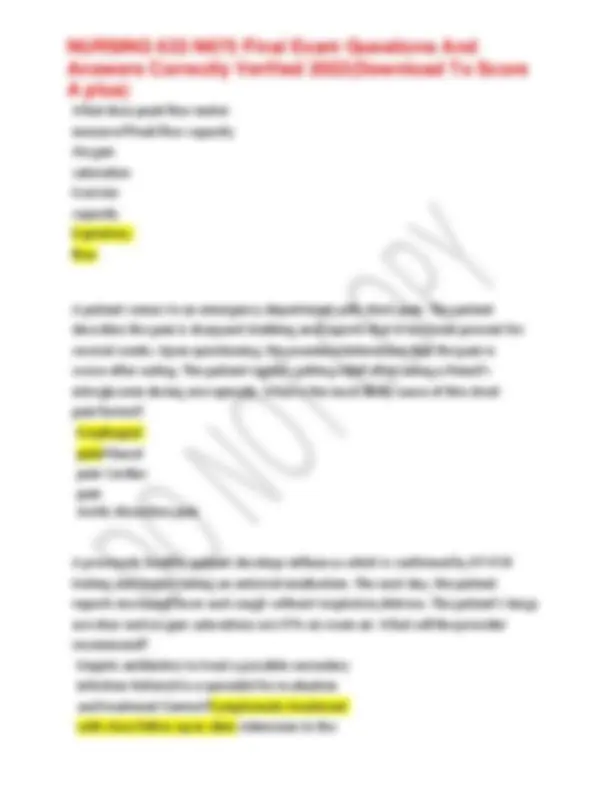
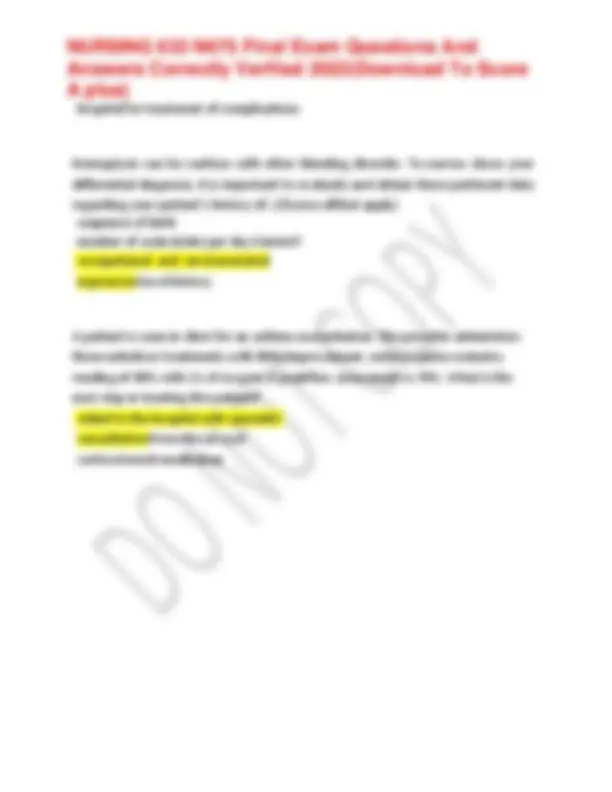
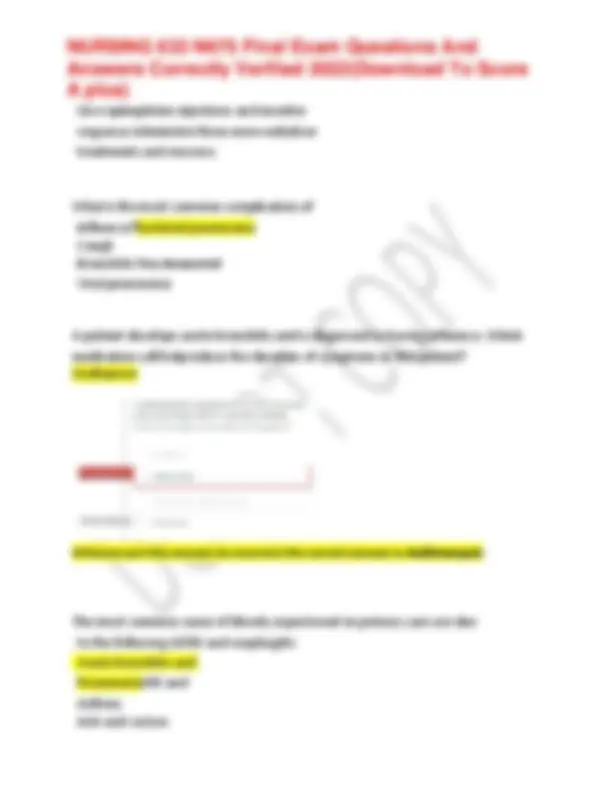
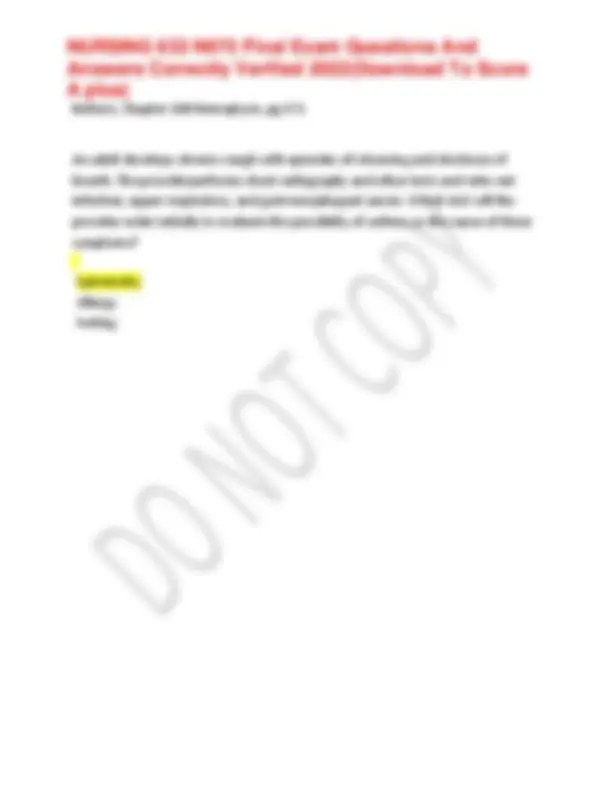
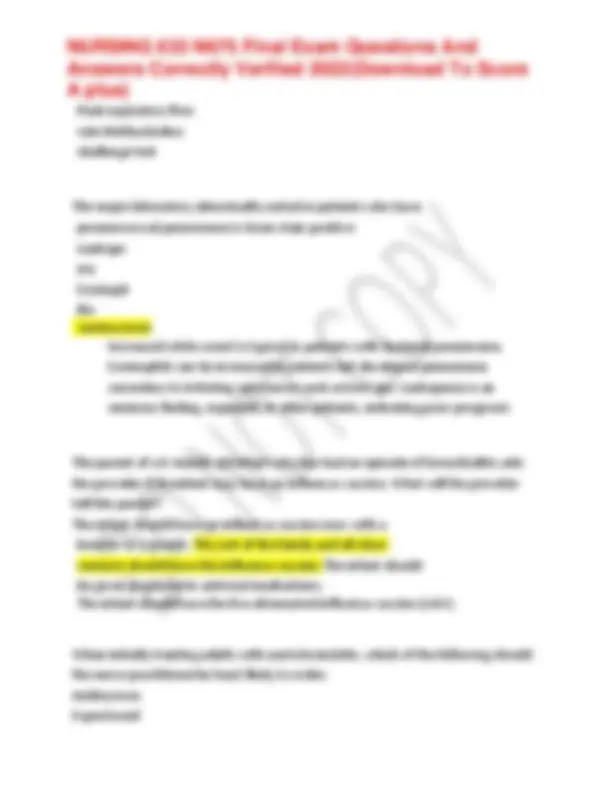
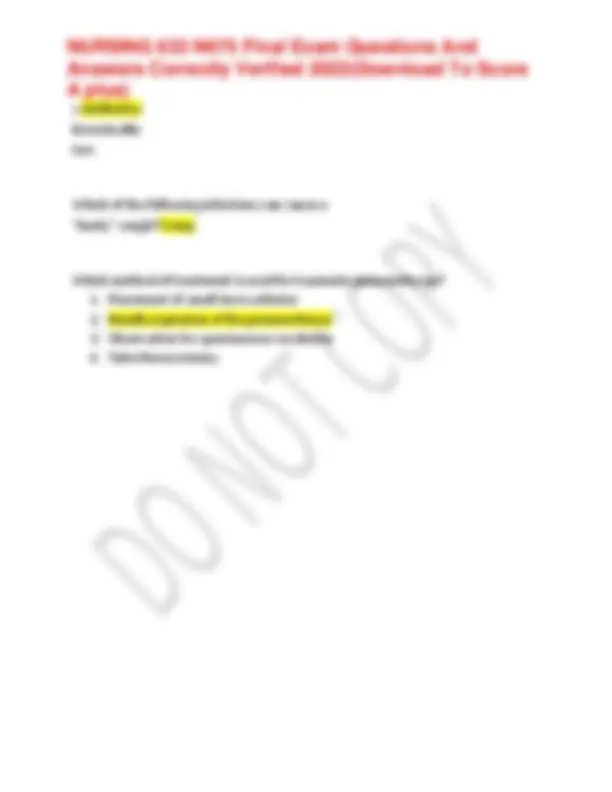
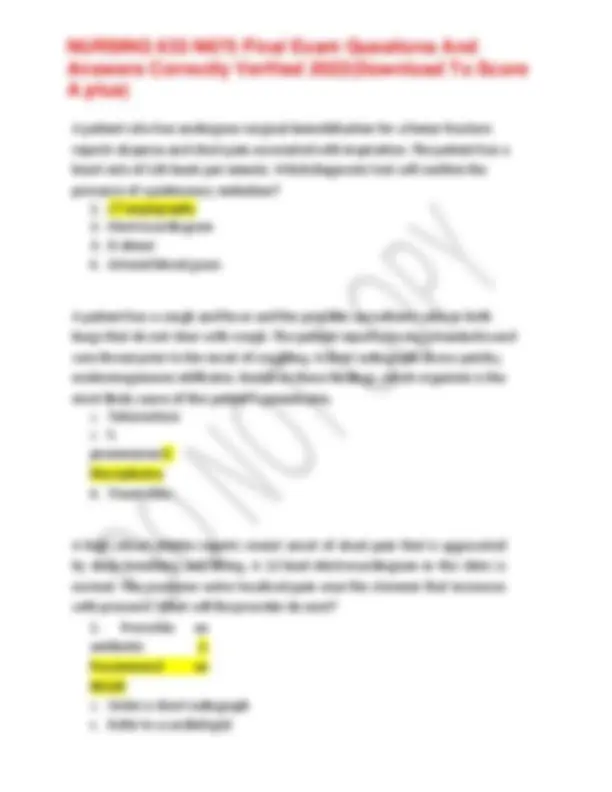
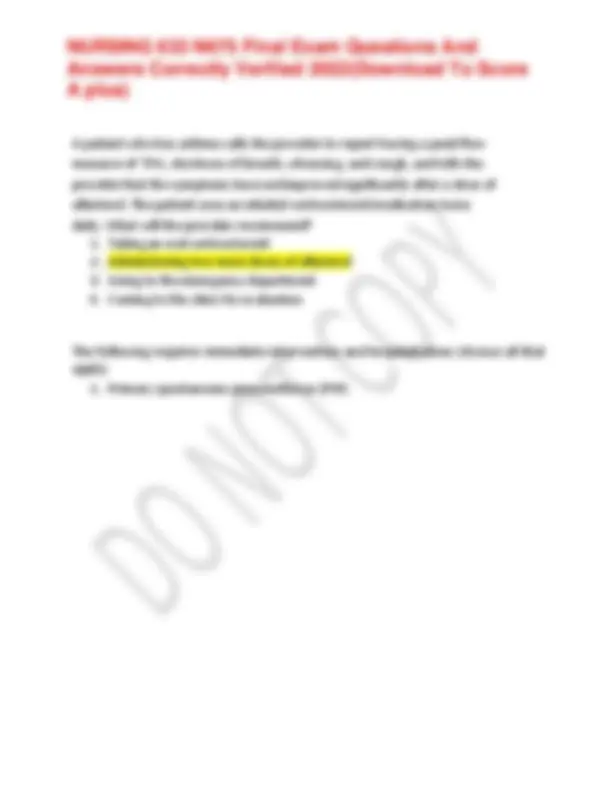
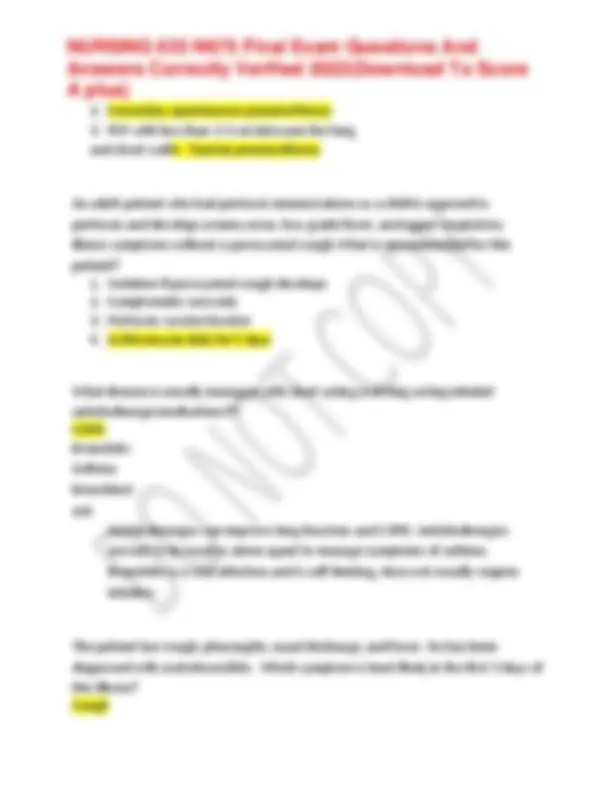
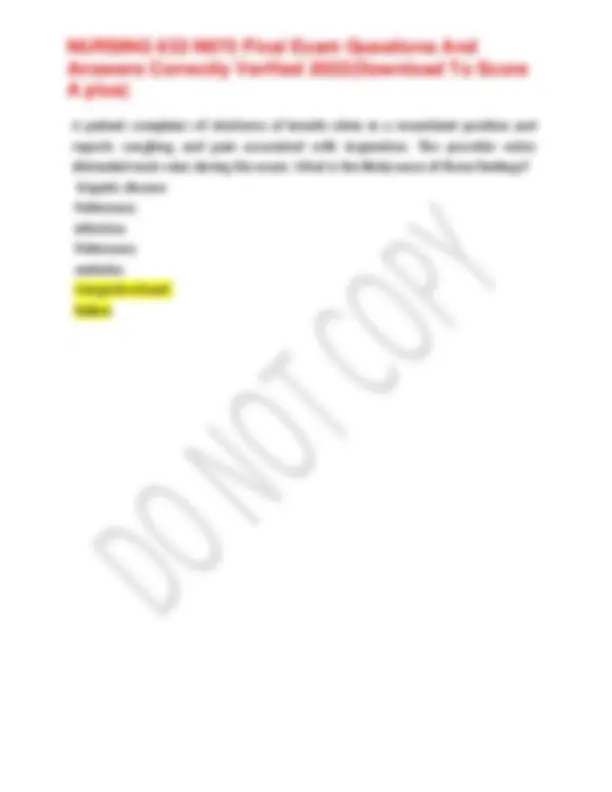
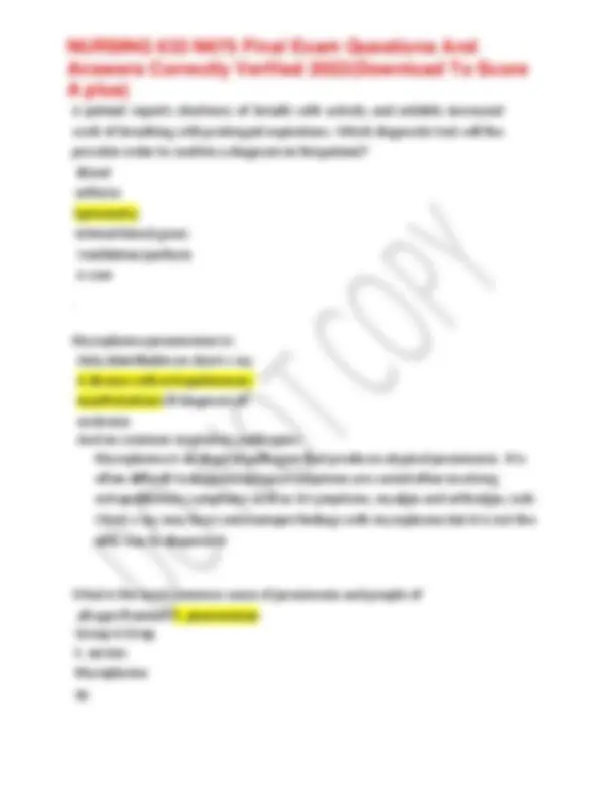
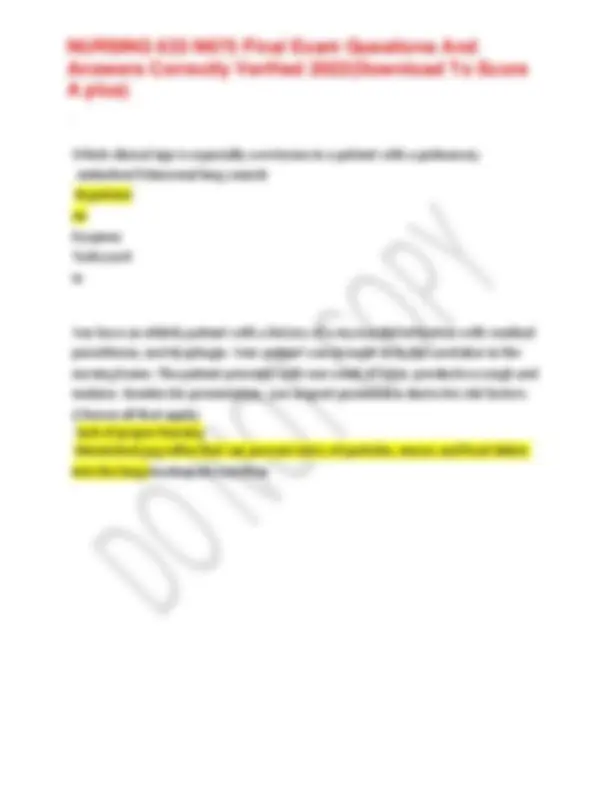
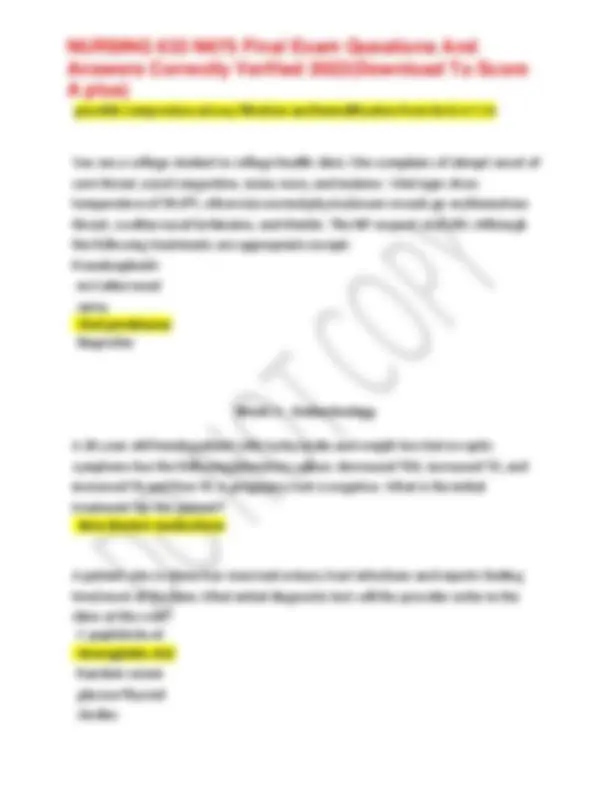
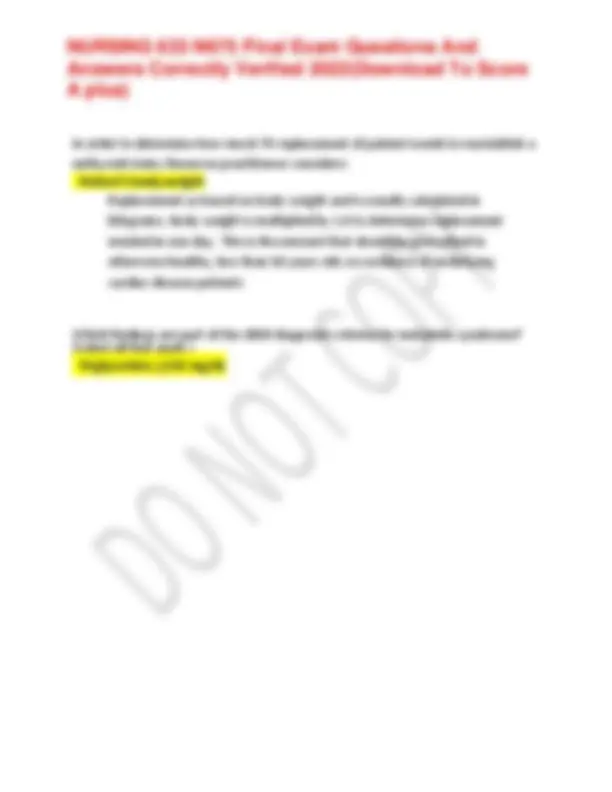
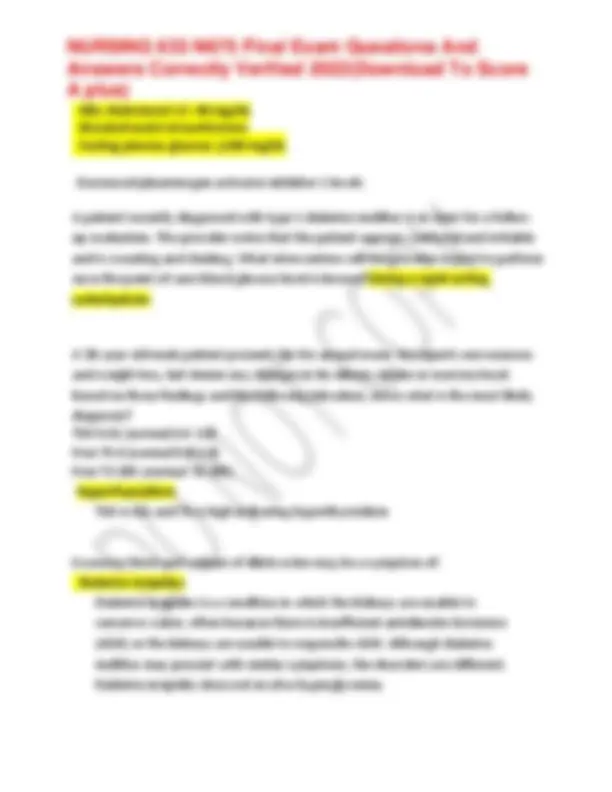
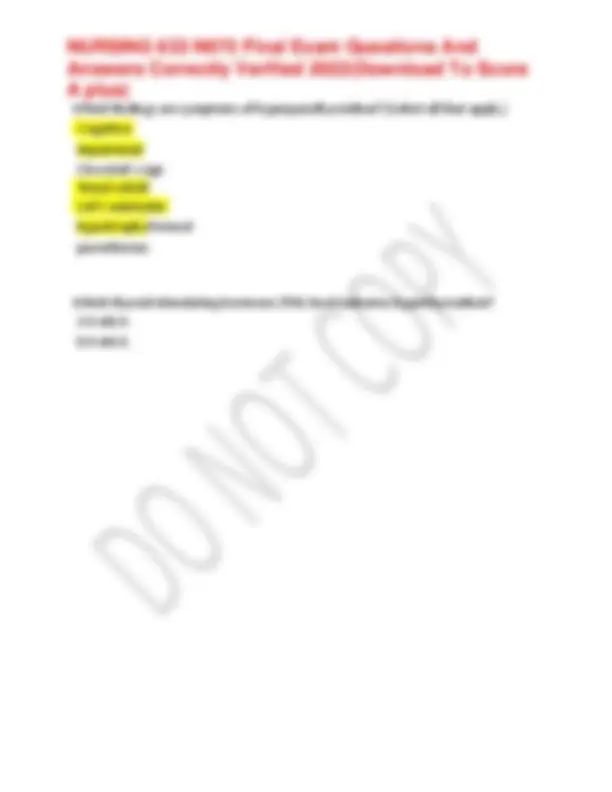
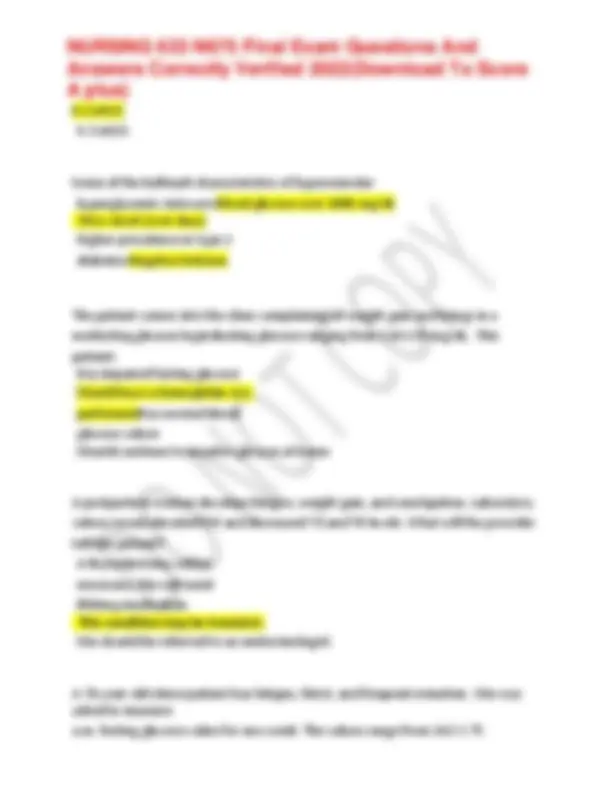
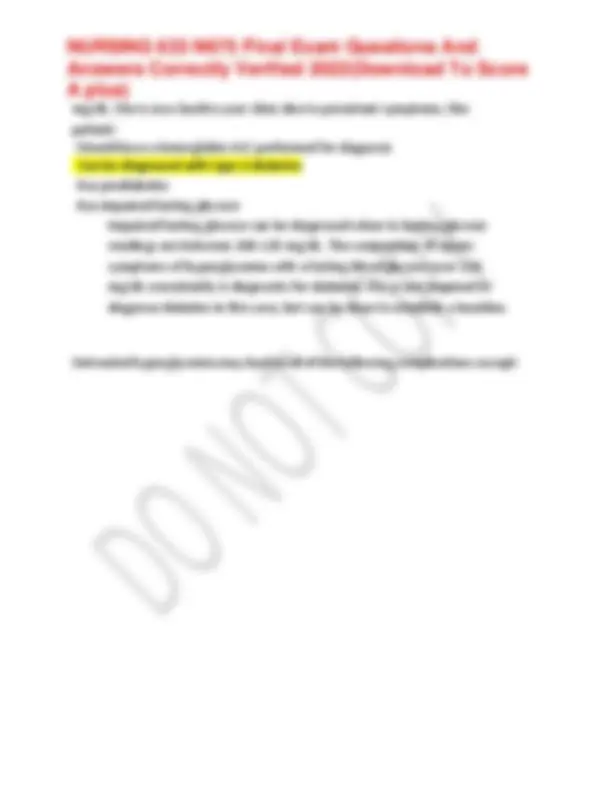
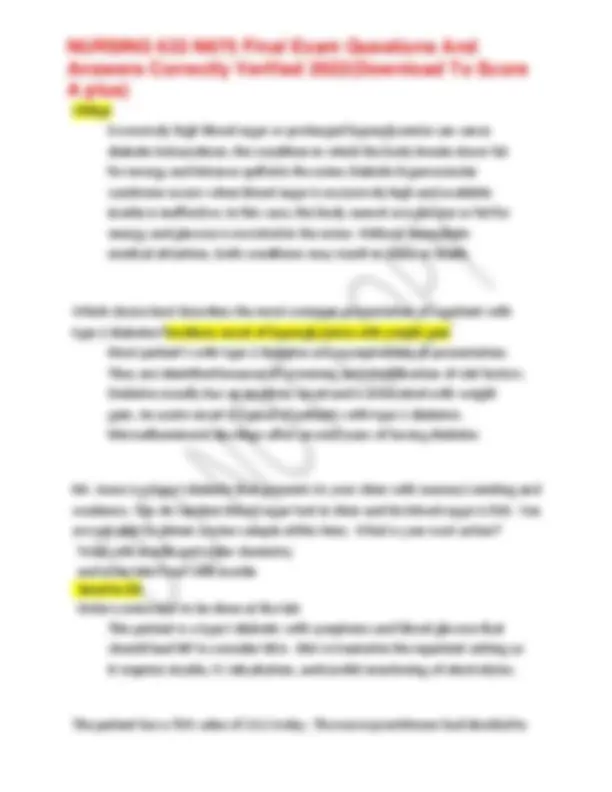
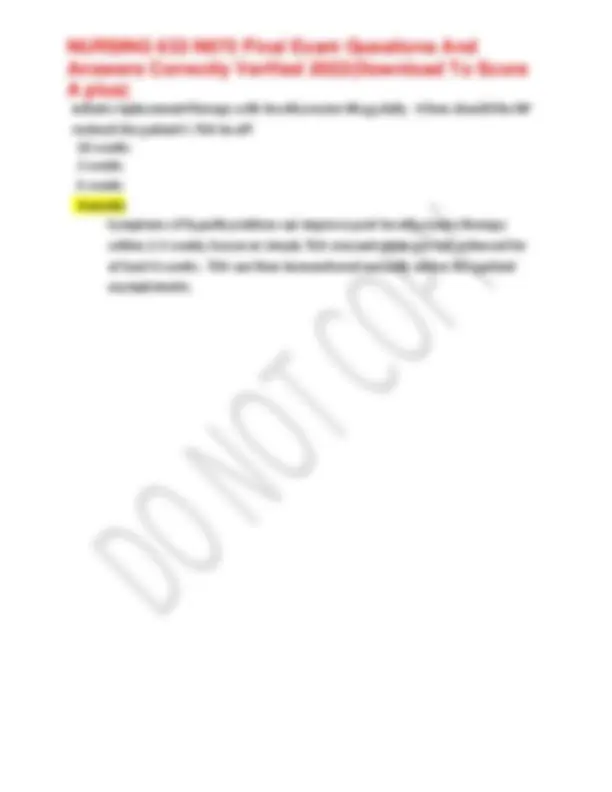
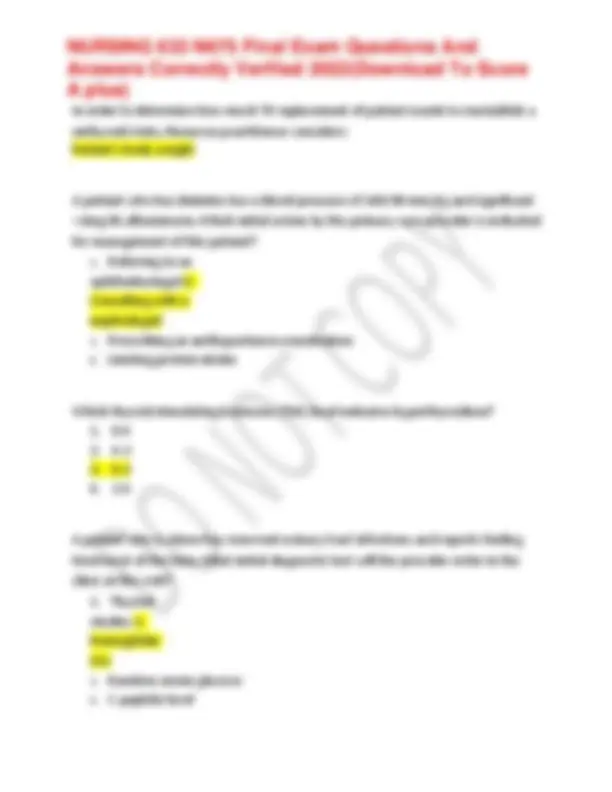
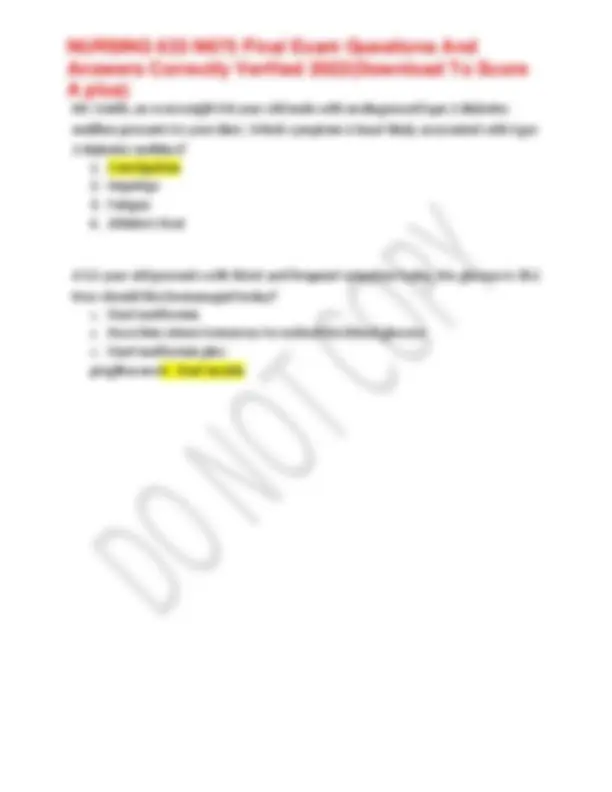
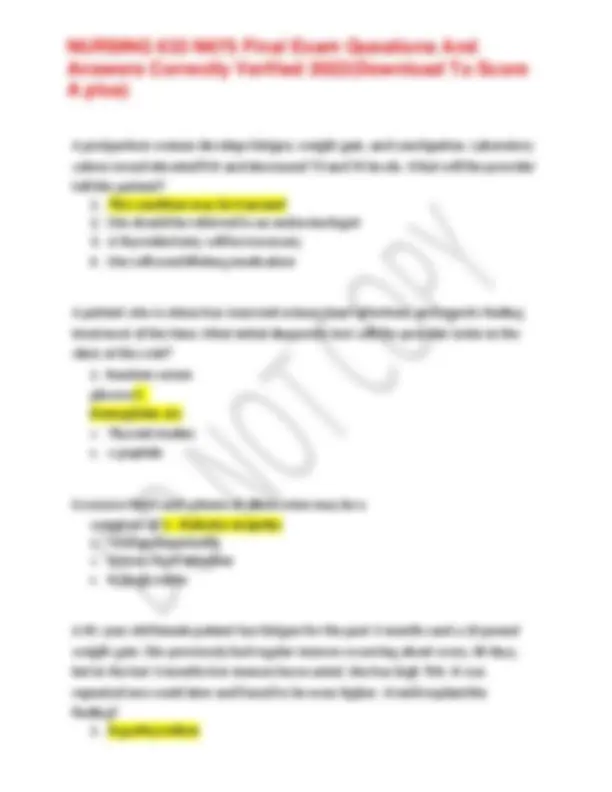
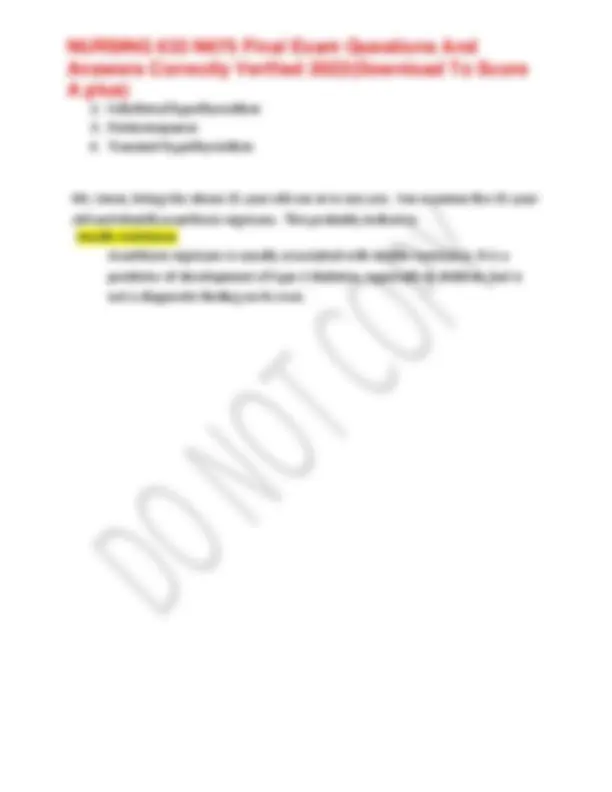
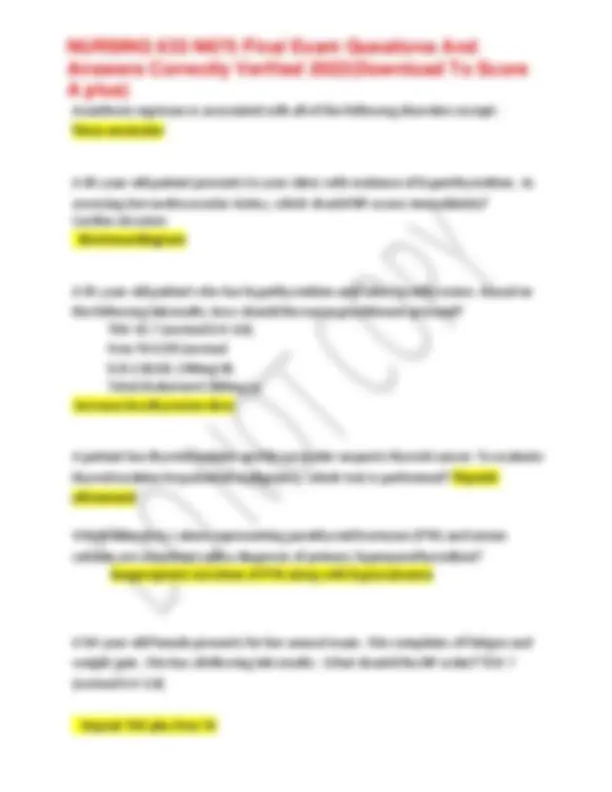
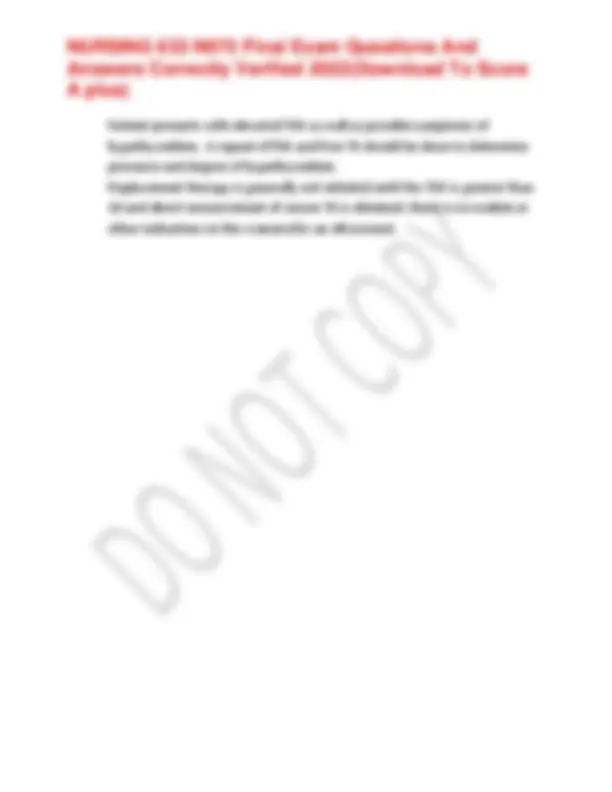
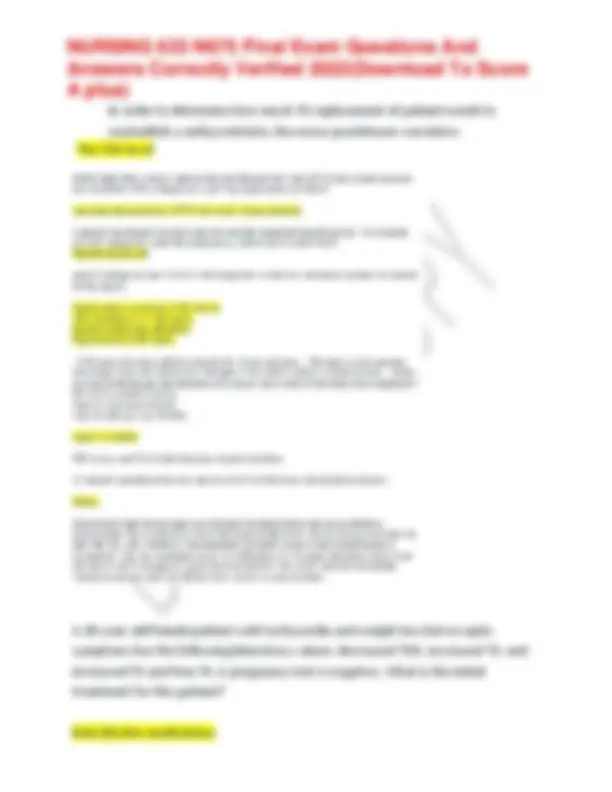

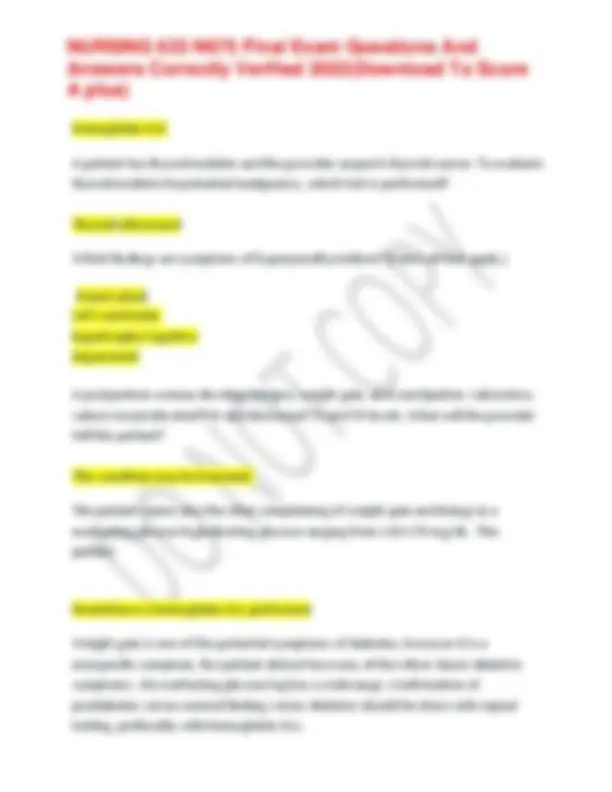

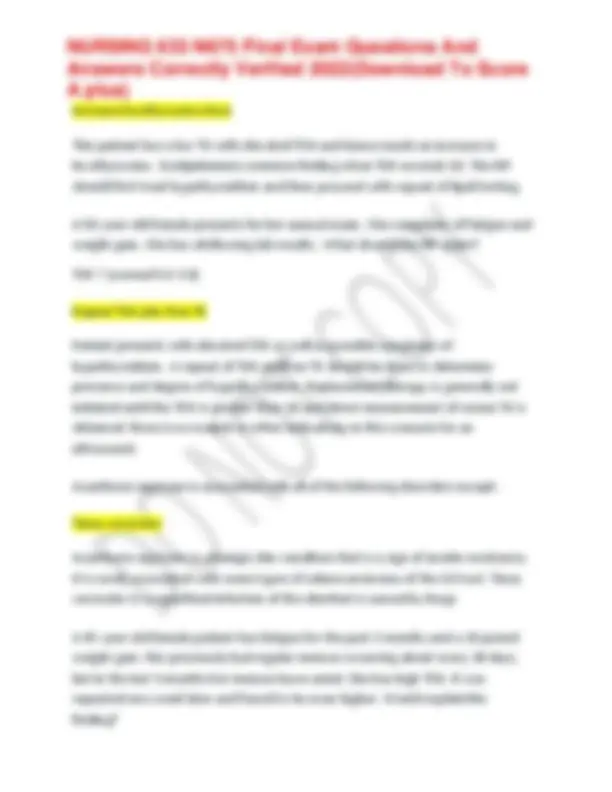
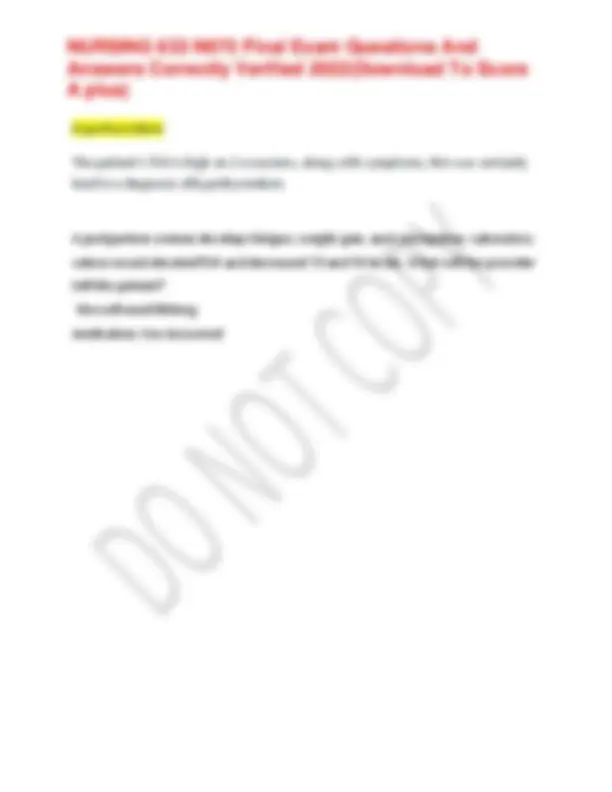
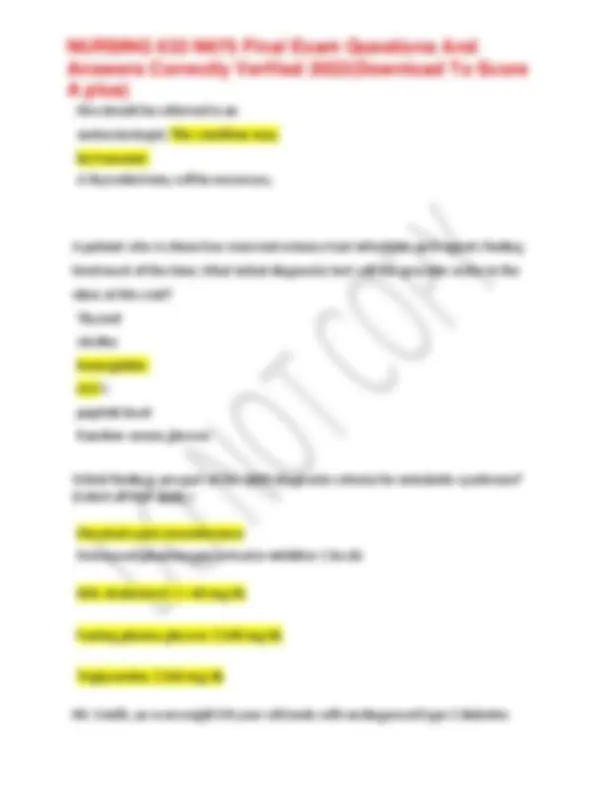
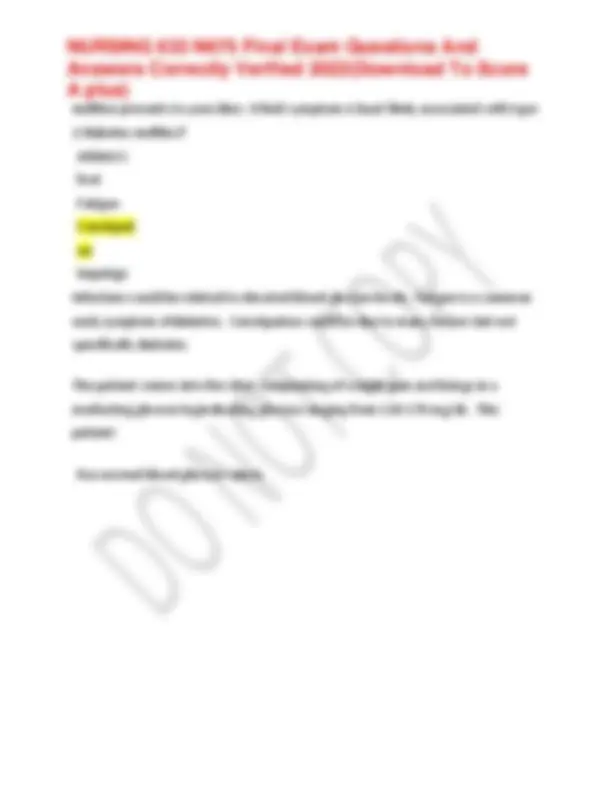
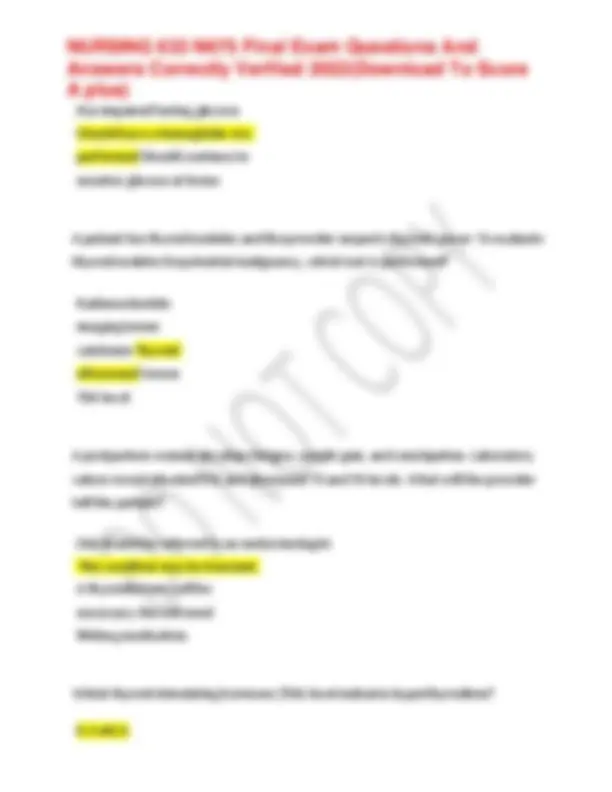
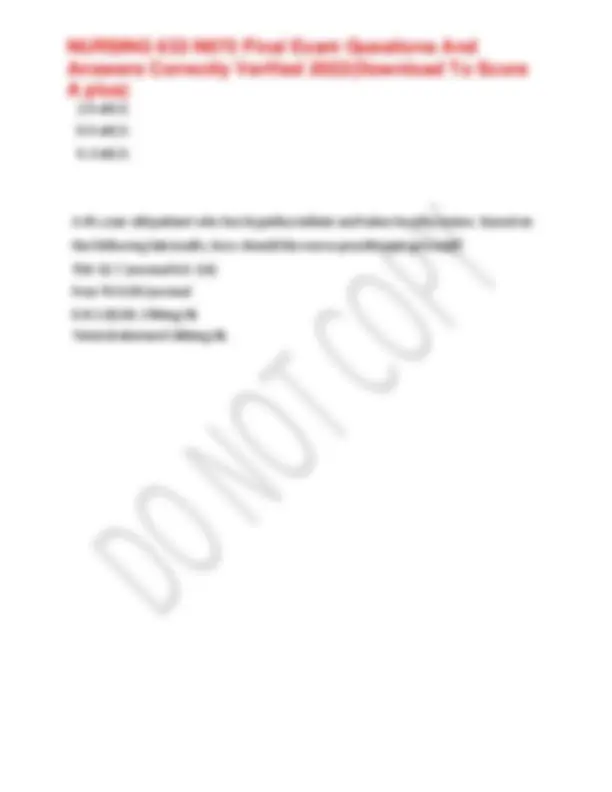
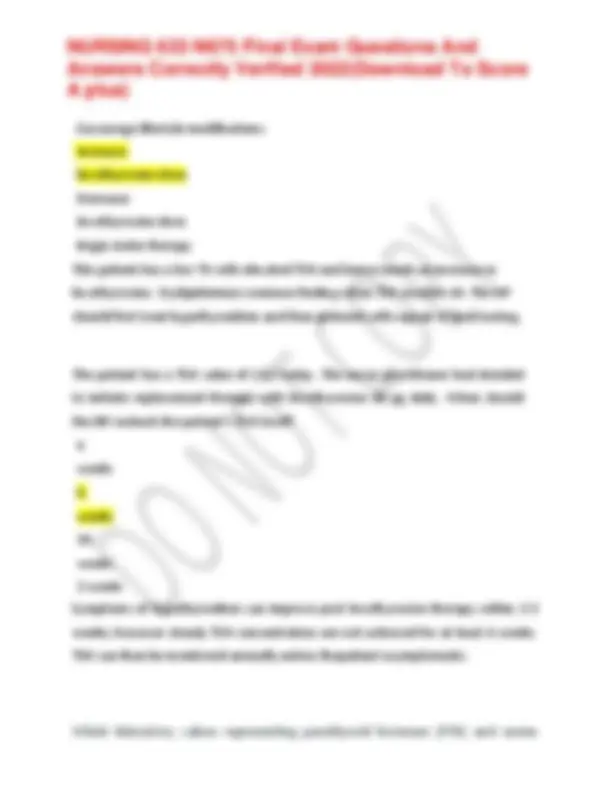
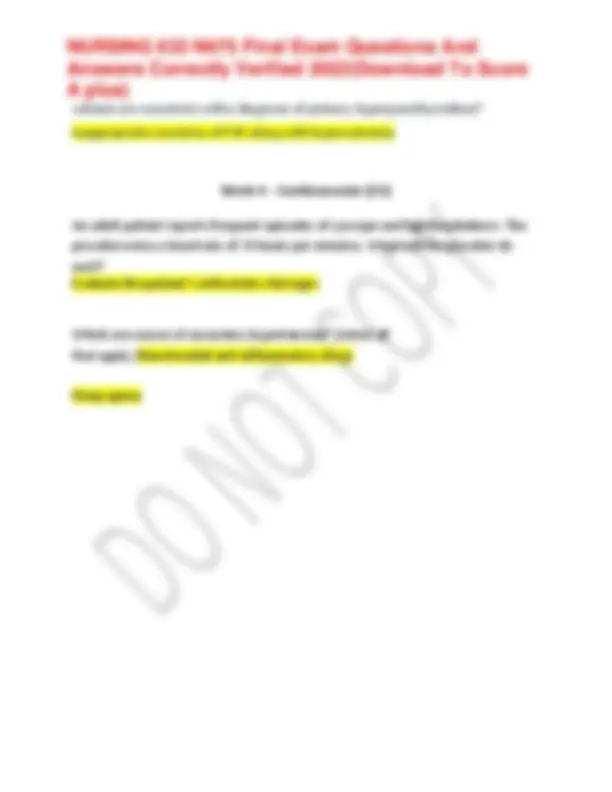
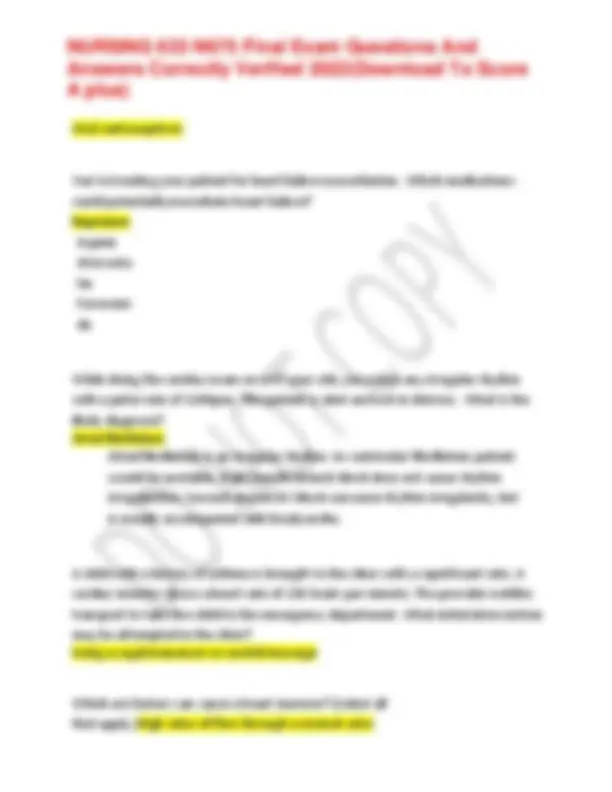
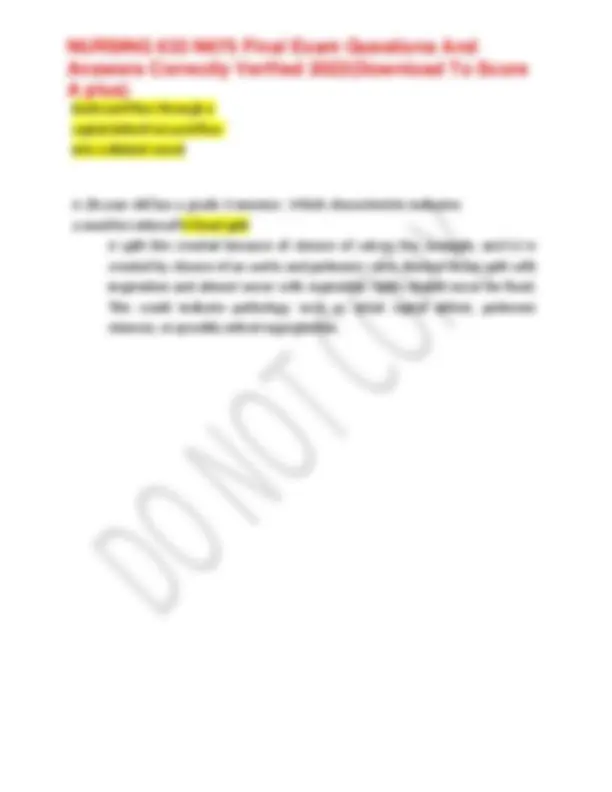
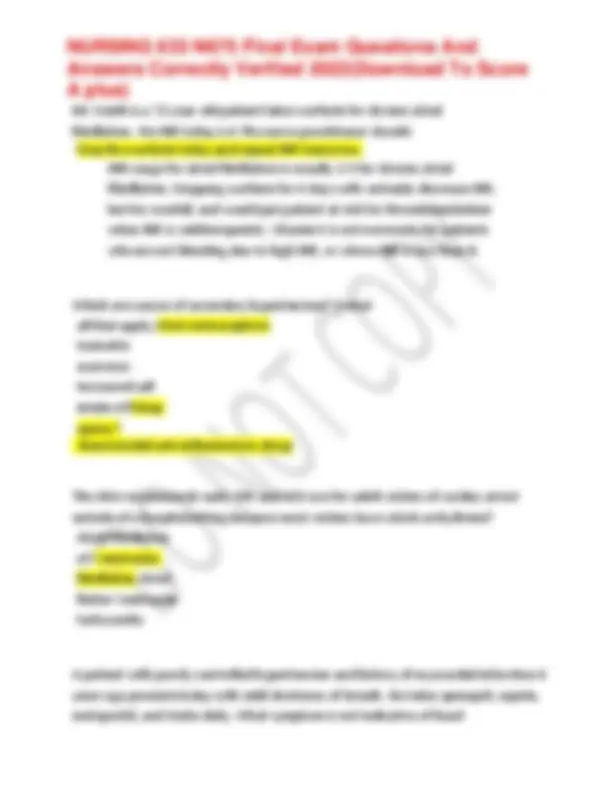
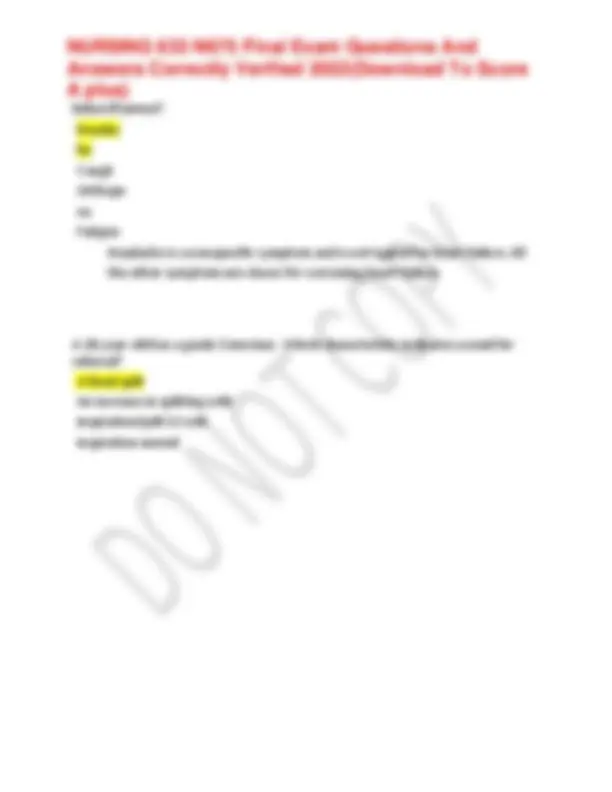
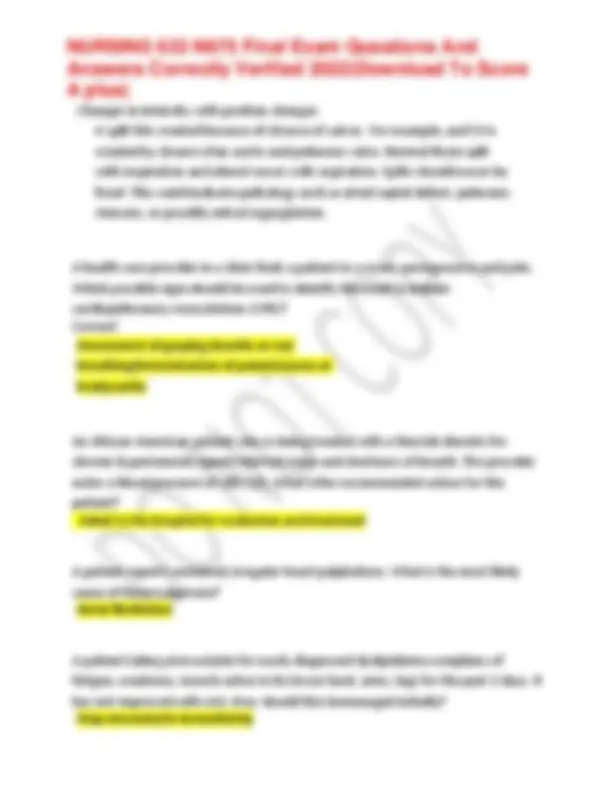
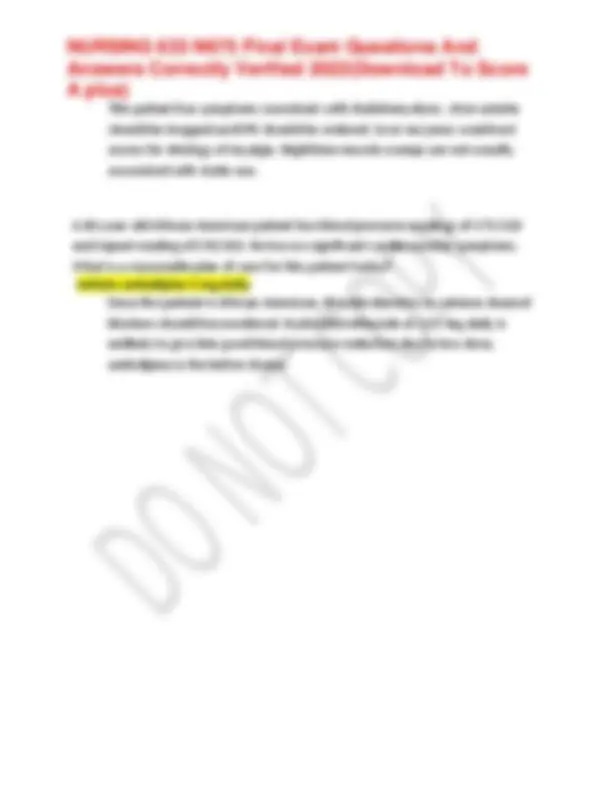
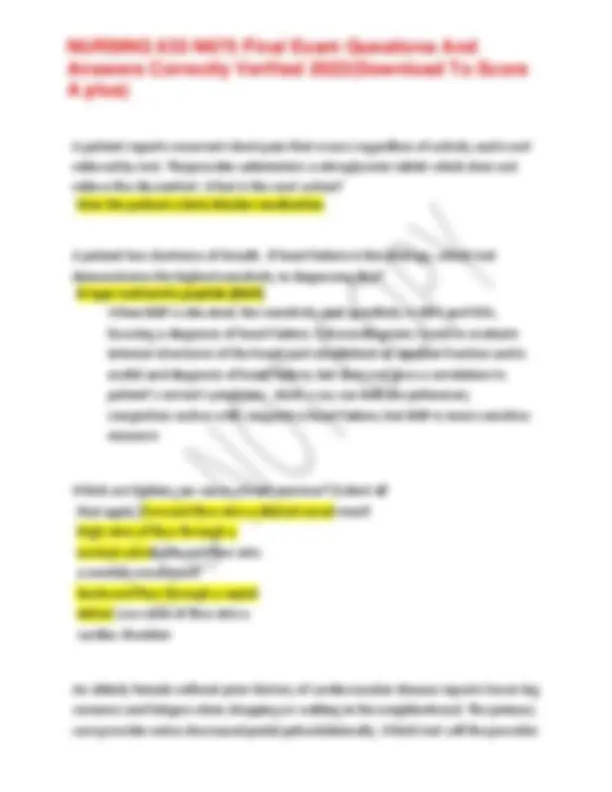
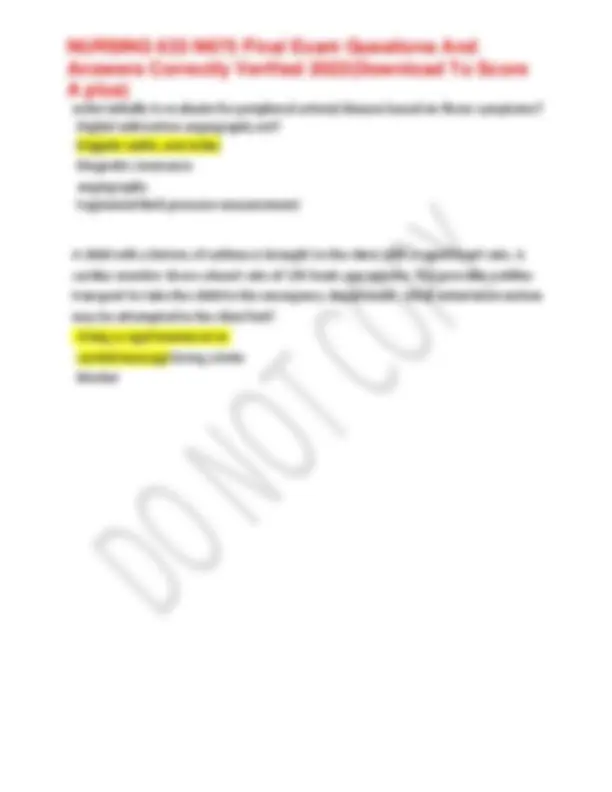
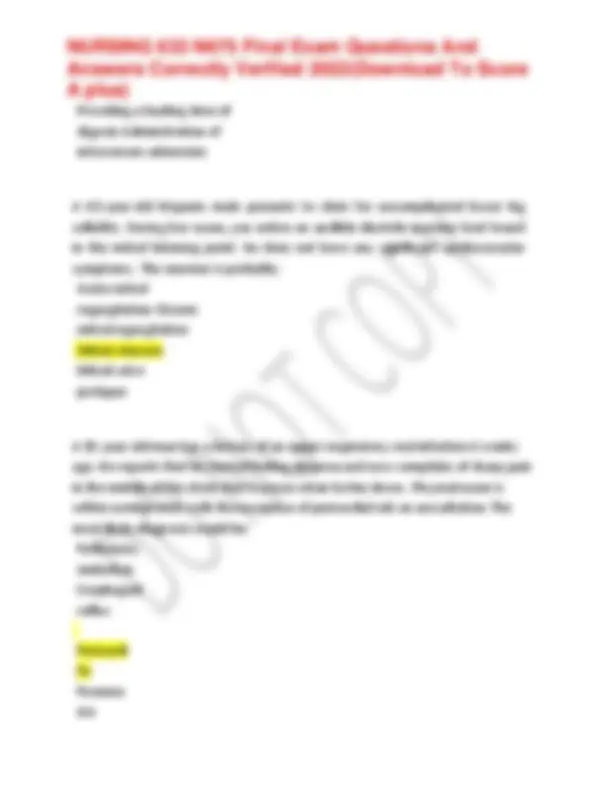
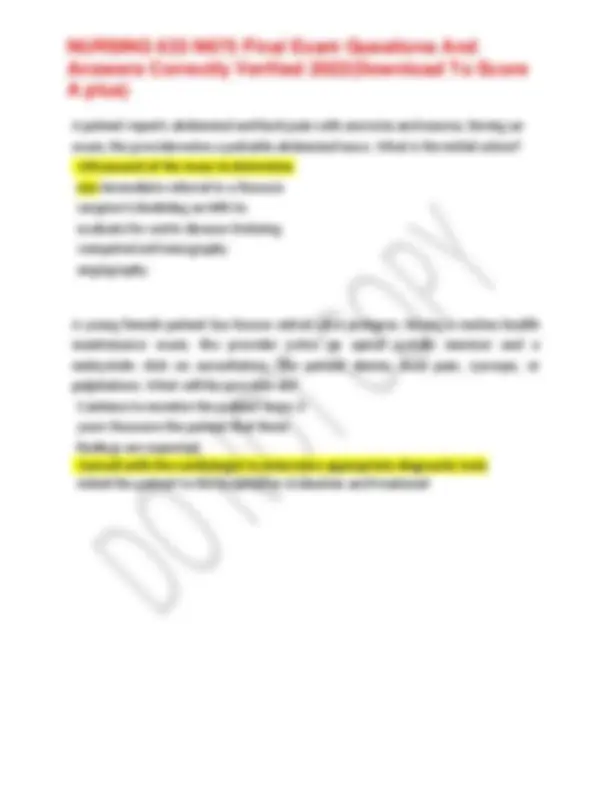
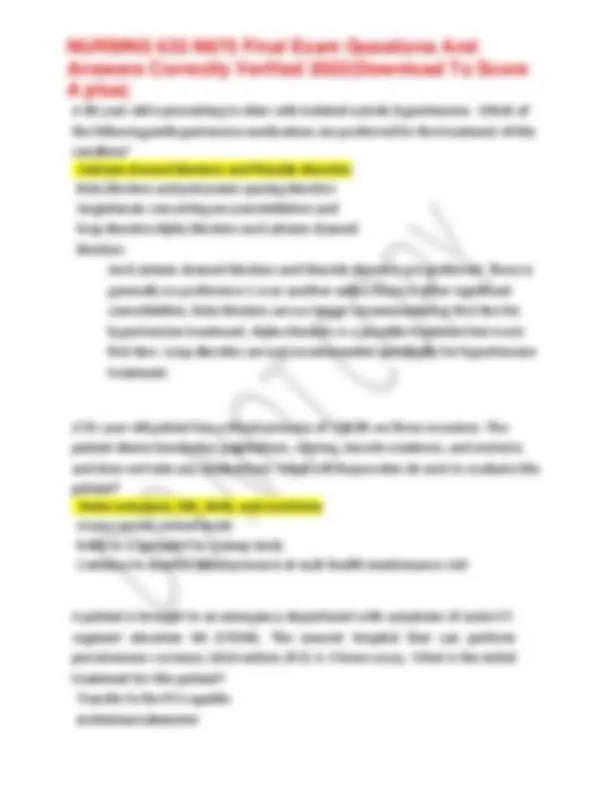
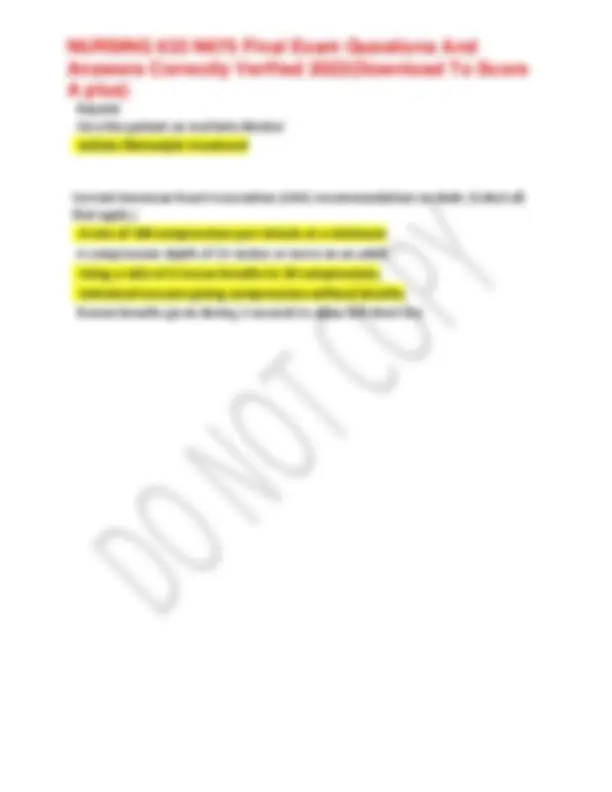
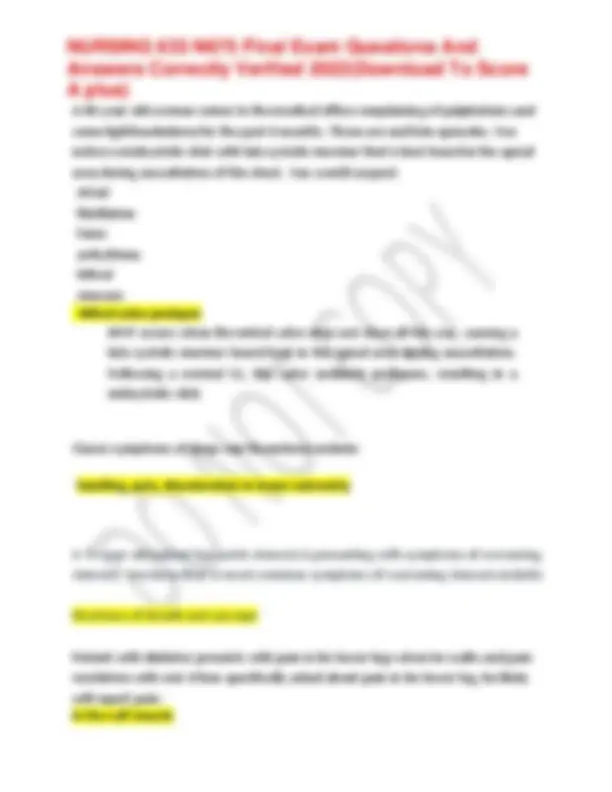
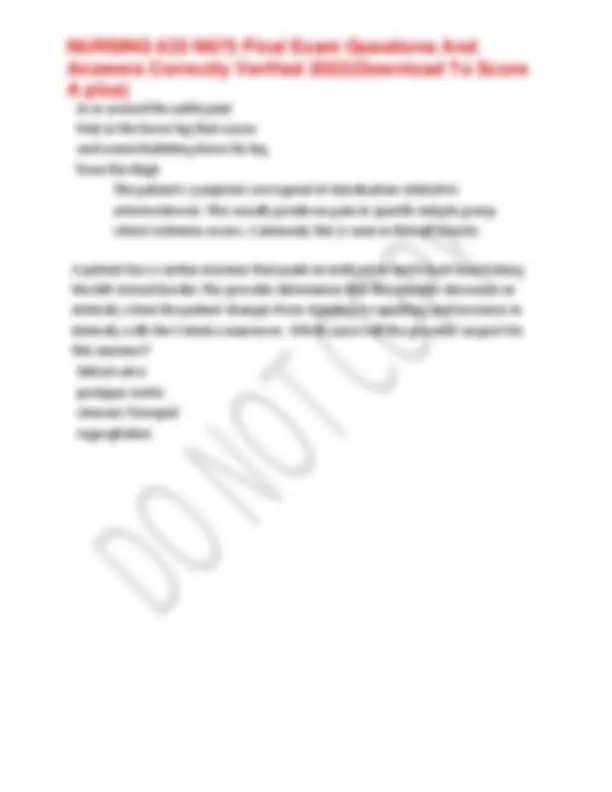
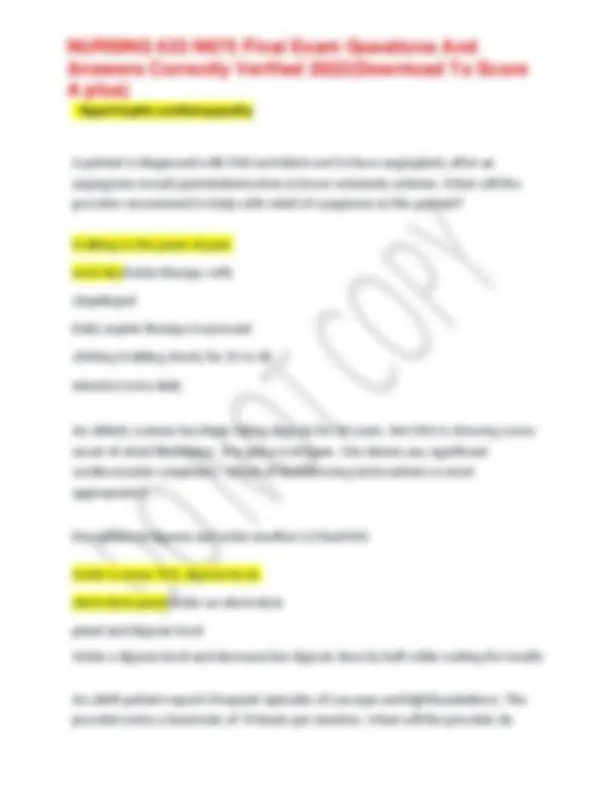
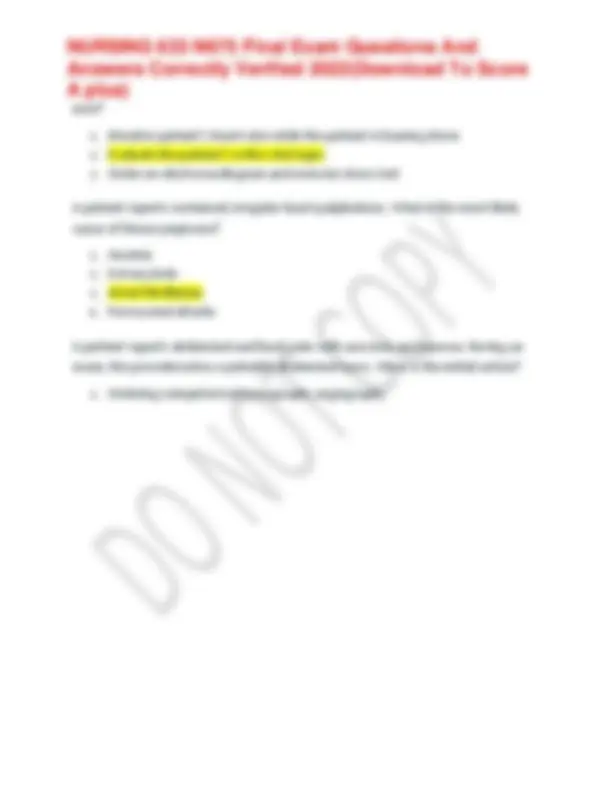
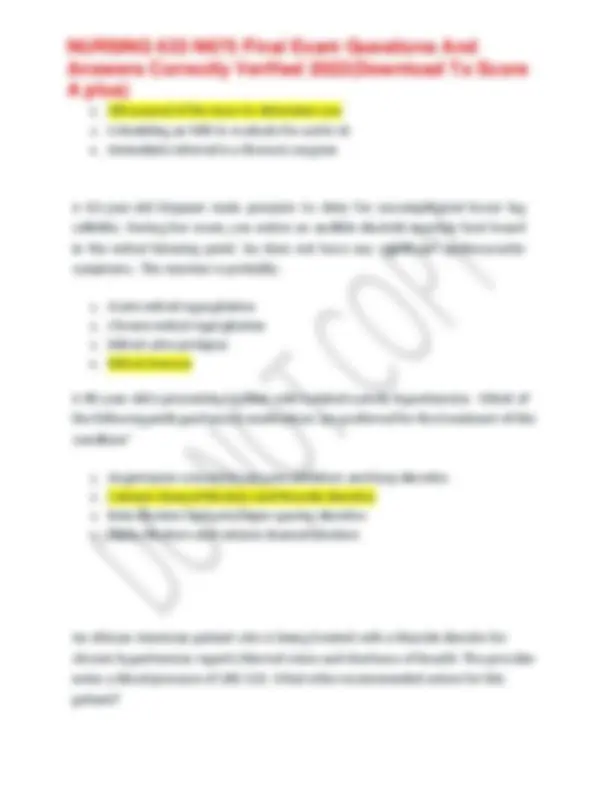
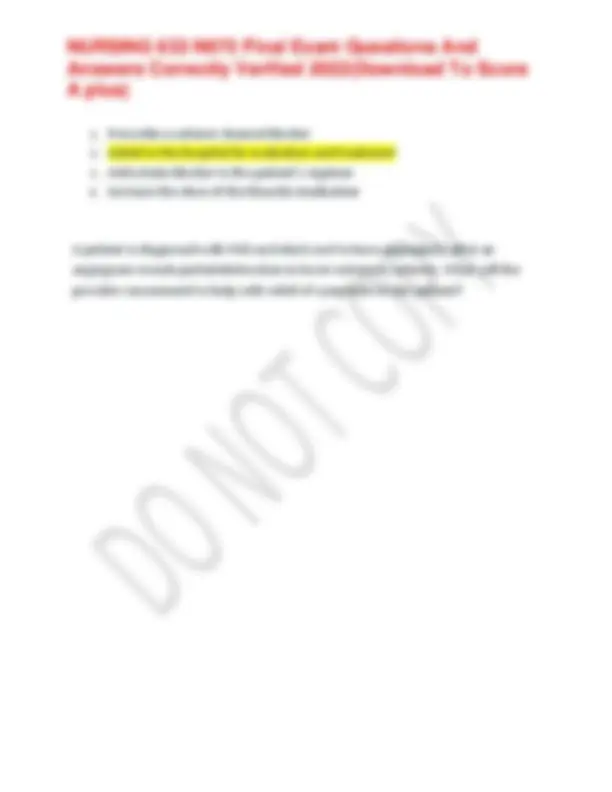
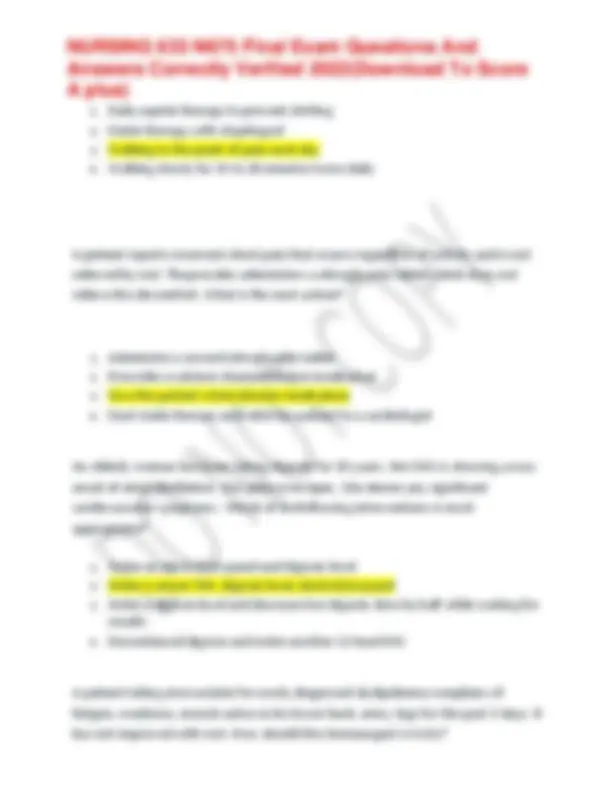
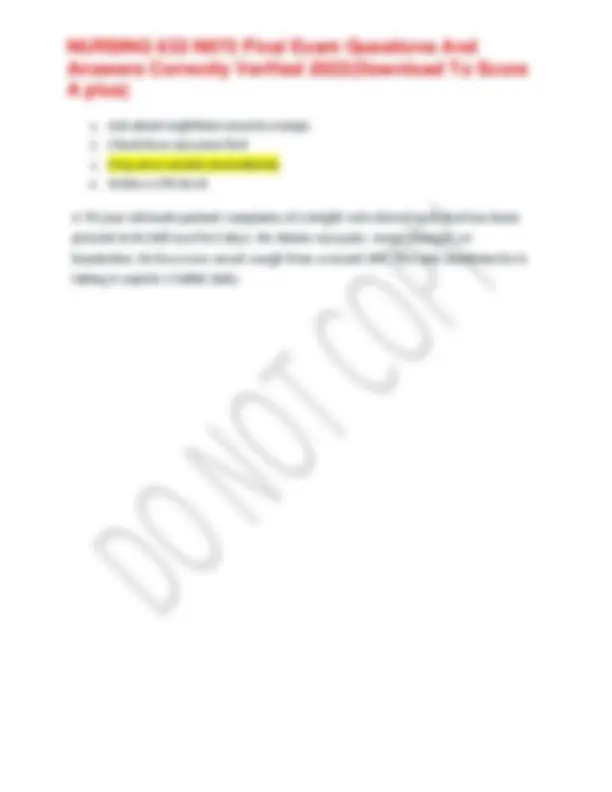
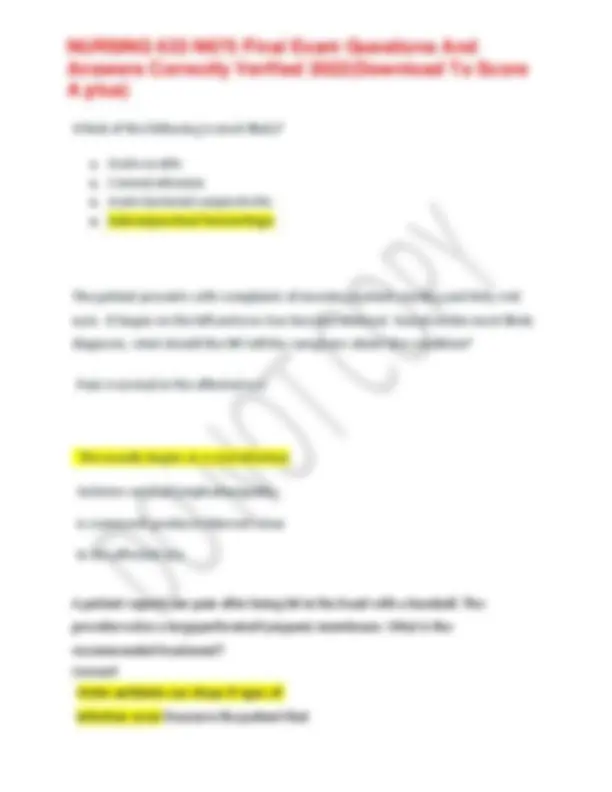
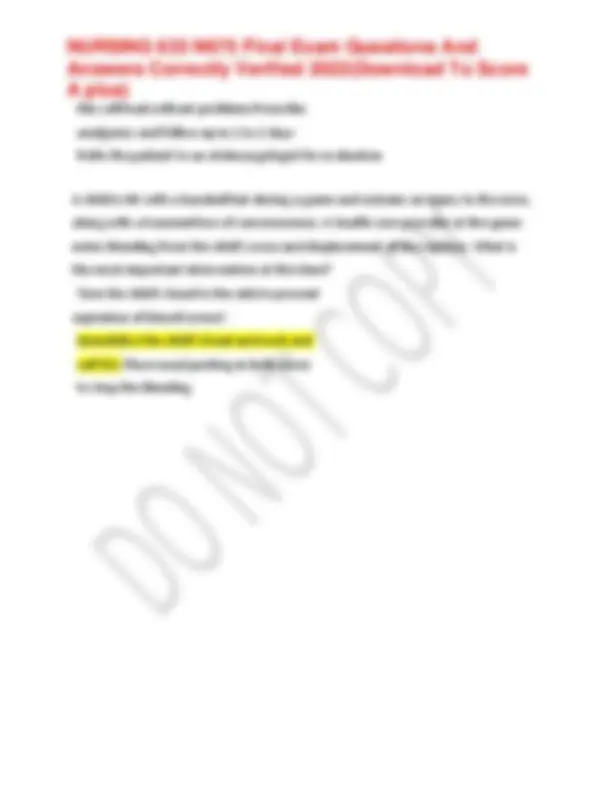
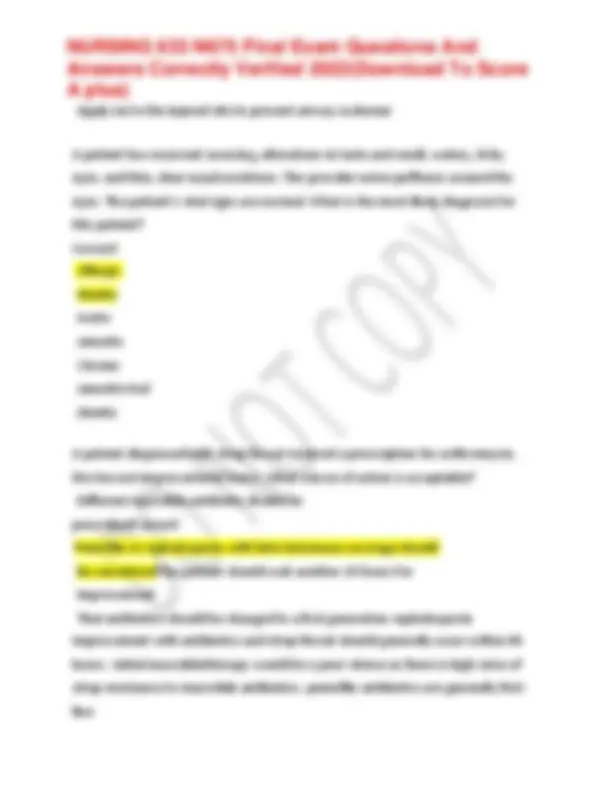
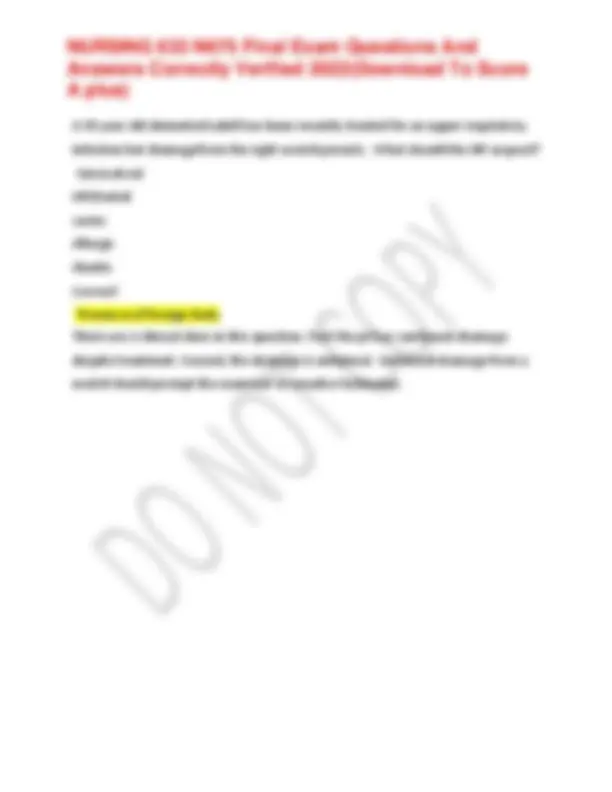
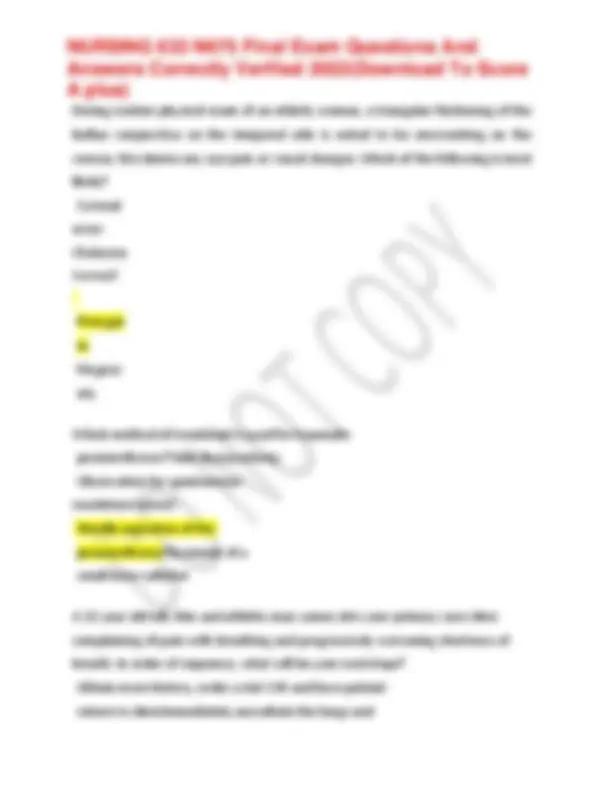
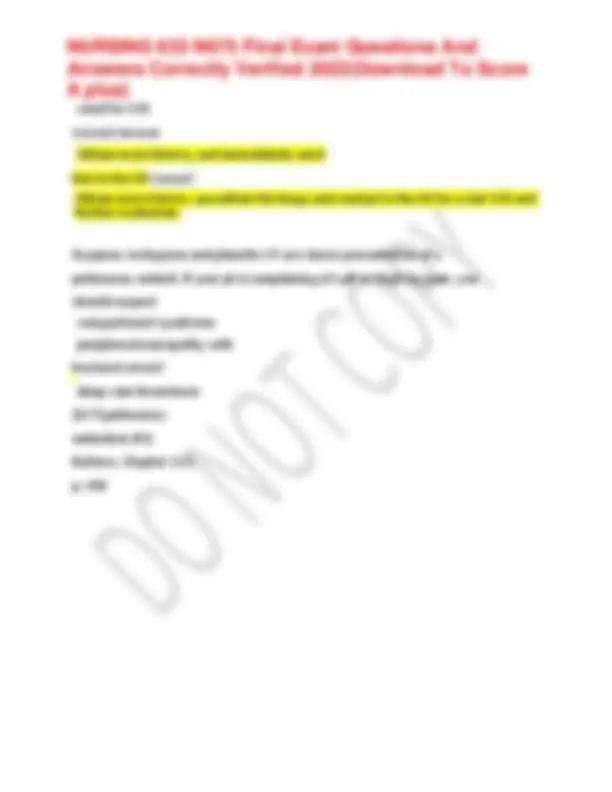
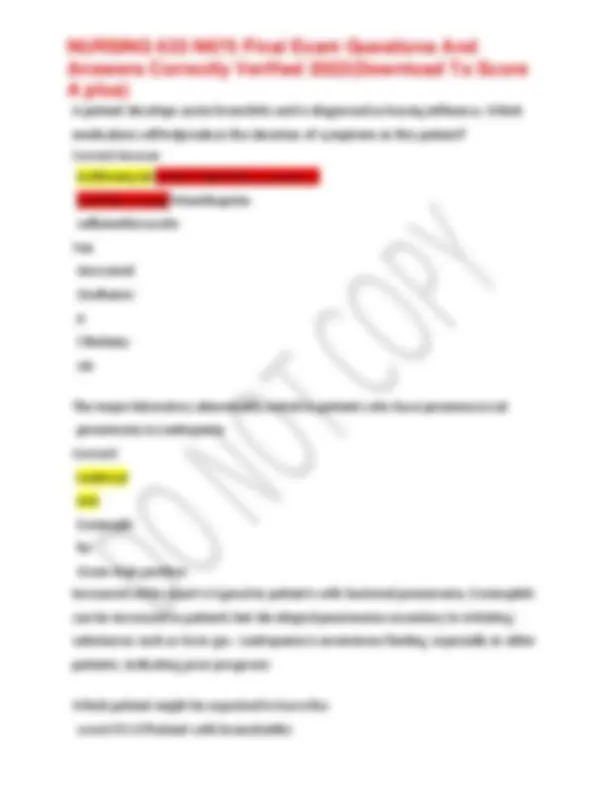
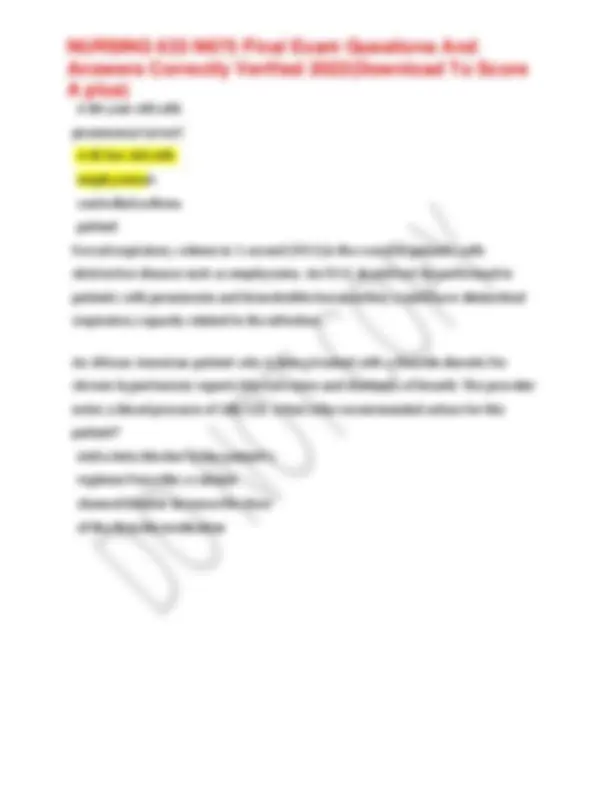


Study with the several resources on Docsity

Earn points by helping other students or get them with a premium plan


Prepare for your exams
Study with the several resources on Docsity

Earn points to download
Earn points by helping other students or get them with a premium plan
Community
Ask the community for help and clear up your study doubts
Discover the best universities in your country according to Docsity users
Free resources
Download our free guides on studying techniques, anxiety management strategies, and thesis advice from Docsity tutors
A series of questions and answers related to acute care and primary care for nursing students. The questions cover a range of topics including ear, nose, and throat conditions, oral lesions, and eye conditions. diagnostic tests, recommended treatments, and management strategies for each condition. The questions are designed to help nursing students prepare for their final exams and are verified for accuracy. useful for students studying nursing and related healthcare fields.
Typology: Exams
1 / 333

This page cannot be seen from the preview
Don't miss anything!





























































































Acute Care Exam 1
Week 1 – EENT
A primary care provider notes painless, hard lesions on a patient’s external ears that expel a white crystalline substance when pressed. What diagnostic test is indicated? Rheumatoid factor Endocrine studies Biopsy of the lesions Uric acid chemical profile
A patient has painful oral lesions and the provider notes several white, verrucous lesions in clusters throughout the mouth. What is the recommended treatment for this patient? Oral hygiene measures Nystatin oral suspension Surgical excision Oral acyclovir
A patient has sore throat, a temperature of 38.5° C, tonsillar exudates, and cervical lymphadenopathy. What will the provider do next to manage this patient’s symptoms? Prescribe empiric penicillin Perform a rapid antigen detection test Refer to an otolaryngologist Order an antistreptolysin O titer
A 61 year old male presents with a 12 hour history of extremely painful left red eye. The patient complains of blurred vision, haloes around lights, and vomiting. It began yesterday evening. On exam, the eye is red, tender and inflamed. The cornea is hazy and pupil reacts poorly to light. The most likely diagnosis in this patient is: Macular degeneration Acute angle glaucoma Increased intracranial pressure Detached cornea
A patient has recurrent epistaxis without localized signs of irritation. Which laboratory tests may be performed to evaluate this condition? (Select all that apply.) CBC with platelets
resolved 2 weeks ago except for a dry cough and pain over his right cheek that worsens when he bends down. The patient denies fever. The patient tells you that he is very allergic to Keflex and erythromycin. Vital signs are stable except temperature is 99.2°F. Which showed the following conditions is most likely? Fever secondary to previous viral URI Acute sinusitis Acute bronchitis Hay fever Patient's symptoms match most closely to acute sinusitis which includes cough, facial pain, low- grade fever
An adult patient has epiglottitis secondary to a chemical burn. Which medication will be given initially to prevent complications? Chloramphenicol biopsyrecu Dexamethasone
Metronidaz ole Clindamyci n
What are factors associated with acute suppurative parotitis? (Select all that apply.) Anticholinergic medications Diabetes mellitus
Radiother apy Hypervole mia Allergies
A 39 year old has a sudden onset of painful right red eye. He reports sensitivity to light and the sensation of a foreign body, though his history for a foreign body is negative. He does not wear contact lenses. How should the NP manage this? Observe for 24 hours if visual acuity is normal Treat for bacterial conjunctivitis Treat for viral conjunctivitis Refer to ophthalmology No clear diagnosis can be made from signs/symptoms, but there are several red flags. collectively the red flags necessitate a referral. There is no mention of eye discharge necessary for conjunctivitis. Red flags present point more towards active corneal process although glaucoma should also be a differential.
A patient has gingival inflammation with several areas of separate ulceration and a small amount of purulent discharge. What is required to diagnose this condition? Culture and sensitivity Tzank smear Physical examination Microscopic exam of oral scrapings
A patient reports tooth pain in a lower molar and the provider notes a mobile tooth with erythema and edema of the surrounding tissues without discharge. Which is the initial course of action by the provider? Recommend oral antiseptic rinses and follow up in one week Perform an incision and drainage of the edematous tissue Prescribe amoxicillin and refer to a dentist in 2 to 3 days Refer to an oral surgeon for emergency surgery
A patient presents to your clinic with a painless red eye. Her vision is normal, but her sclera has a blood red area. What is this termed? Conjunctiv itis Glaucoma Acute iritis Subconjunctival hemorrhage
Which physical examination finding suggests viral rather than bacterial parotitis? Unilateral edema of parotid glands Enlargement and pain of
affected glands Gradual reduction in saliva production Clear discharge from Stensen’s duct
A child is hit with a baseball bat during a game and sustains an injury to the nose, along with a transient loss of consciousness. A health care provider at the game notes bleeding from the child’s nose and displacement of the septum. What is the most important intervention at this time? Immobilize the child’s head and neck and call 911 Turn the child’s head to the side to prevent aspiration of blood Place nasal packing in both nares to stop the bleeding Apply ice to the injured site to prevent airway occlusion
Group A strep is usually accompanied by multiple symptoms with abrupt onset. GI symptoms are common such as nausea, vomiting, no abdominal pain. Inflamed uvula is not common
Which symptoms may occur with vestibular neuritis? (Select all that apply.) Nausea and vomiting
Disequilibri um Fever Tinnitus Hearing loss
A patient who has acute suppurative parotitis has been taking amoxicillin- clavulanate for 4 days without improvement in symptoms. The provider will order an antibiotic for Methicillin-resistant S. aureus. Which other measure may be helpful? Discouraging chewing gum
Topical corticosteroids Cool compresses Surgical drainage
A NP preforms a fundoscopic exam. He identifies small areas of dull, yellowish- white coloration in the retina. What might these be? Cotton wool spots Hemorrhages Exudates Microaneurys m
The provider sees a child with a history of high fever and sore throat. When entering the exam room, the provider finds the child sitting in the tripod position and notes stridor, drooling, and anxiety. What is the initial action for this patient? Administer empiric intravenous antibiotics and steroids Obtain an immediate consultation with an otolaryngologist Perform a thorough examination of the oropharynx Have the child lie down and administer high-flow, humidified oxygen
A patient reports ear pain after being hit in the head with a baseball. The provider notes a large perforated tympanic membrane. What is the recommended treatment? Prescribe analgesics and follow up in 1 to 2 days Order antibiotic ear drops if signs of infection occur Refer the patient to an otolaryngologist for evaluation Reassure the
Antihistamine sprays Intranasal comolyn Oral antihistamine
A patient with gingival inflammation with several areas of separated ulceration and a small amount of purulent discharge. What is required to diagnose this condition? Microscopic exam of oral scrapings Physical examination Tzank smear Culture and sensitivity
A 70 year old male has a yellowish, triangular nodule near the iris. This is probably: A chalazion A pinguecul a A stye Subconjunctival hemorrhage.
A 32-year-old patient is a newly diagnosed diabetic. She has developed a sinus infection. Her symptoms have persisted for 10 days. 6 weeks ago, she was treated with amoxicillin for a URI. It cleared without incident. Which be recommended today? Prescribe amoxicillin again Do not prescribe an antibiotic, only a decongestant as indicated Prescribe amoxicillin- clavulanate today Prescribe a decongestant and an antihistamine
A patient has recurrent sneezing, alterations in taste and smell, watery, itchy eyes, and thin, clear nasal secretions. The provider notes puffiness around the eyes. The patient’s vital signs are normal. What is the most likely diagnosis for this patient? Allergic rhinitis Acute sinusitis Viral rhinitis Chronic sinusitis
The patient presents with complaints of morning eyelash crusting and itchy red eyes. It began on the left and now has become bilateral. Based on the most likely diagnosis, what should the NP tell the caregivers about this condition?
otolaryngologist A trial of azithromycin A CT scan of the paranasal sinuses A second course of amoxicillin-clavulanate
A patient reports several episodes of acute vertigo, some lasting up to an hour, associated with nausea and vomiting. What is part of the initial diagnostic workup for this patient? Auditory brainstem testing Electrocochleograph y Vestibular testing Audiogram and MRI
A patient has two palpable, tender, left preauricular nodes that are about 0.5cm in diameter. What condition might this be associated with? Ear infection Conjunctiv itis Ulceration on the tongue Sore throat
A kindergarten teacher was diagnosed with acute streptococcal pharyngitis. On exam, her throat is bright red color with no tonsillar exudate, and clear mucus is seen on the lower nasal turbinates. The urinalysis shows a large amount of white blood cells and is positive for nitrates. The patient has a significant sulfa allergy and thinks she is also allergic to penicillin. Which with the following is the best treatment choice? Levofloxacin Amoxicillin– clavulanic acid Trimethoprim– sulfamethoxazole Clarithromycin
During routine physical exam of an elderly woman, a triangular thickening of the bulbar conjunctiva on the temporal side is noted to be encroaching on the cornea. She denies any eye pain or visual changes. Which of the following is most likely? Corneal arcus Pterygium Chalazion Pinguecul
Prescribe an ophthalmic antibiotic solution Advise the patient that the condition is benign and will resolve spontaneously
A patient reports painful oral lesions 3 days after feeling pain and tingling in the mouth. The provider notes vesicles and ulcerative lesions on the buccal mucosa. What is the most likely cause of these symptoms?
A patient diagnosed with strep throat received a prescription for azithromycin. She has not improved in 48 hours. What course of action is acceptable?
A patient is concerned about frequent nasal stuffiness and congestion that begins shortly after getting out of bed in the morning. The patient denies itching and sneezing. A physical examination reveals erythematous nasal mucosa with scant watery discharge. What treatment will the provider recommend for this patient?
What is the initial intervention for this patient
A patient presents to your clinic with a painless red eye. Her vision is normal, but her sclera has a blood red area. What is this termed?